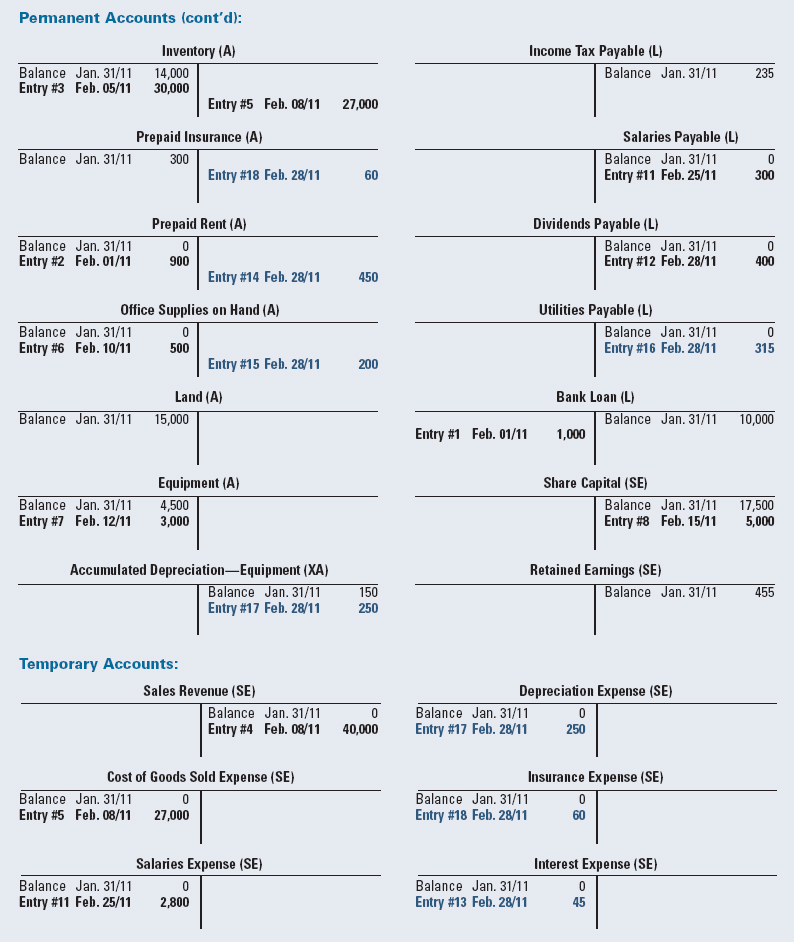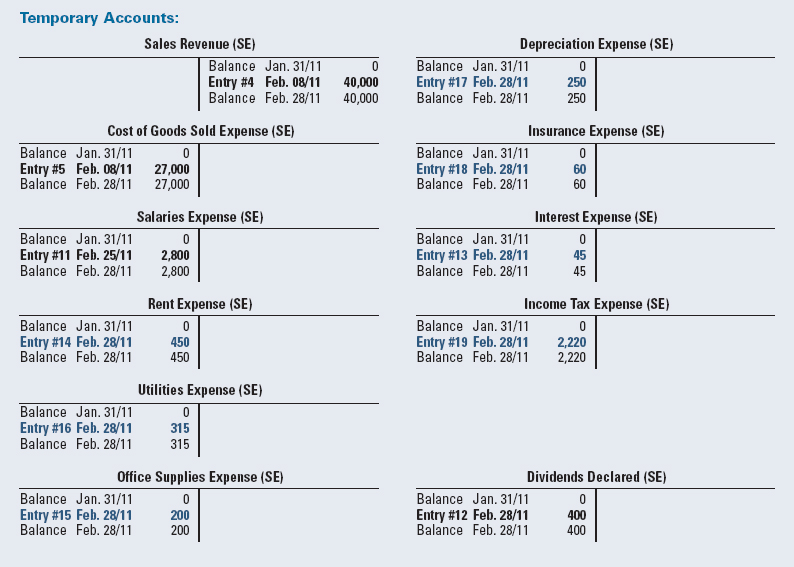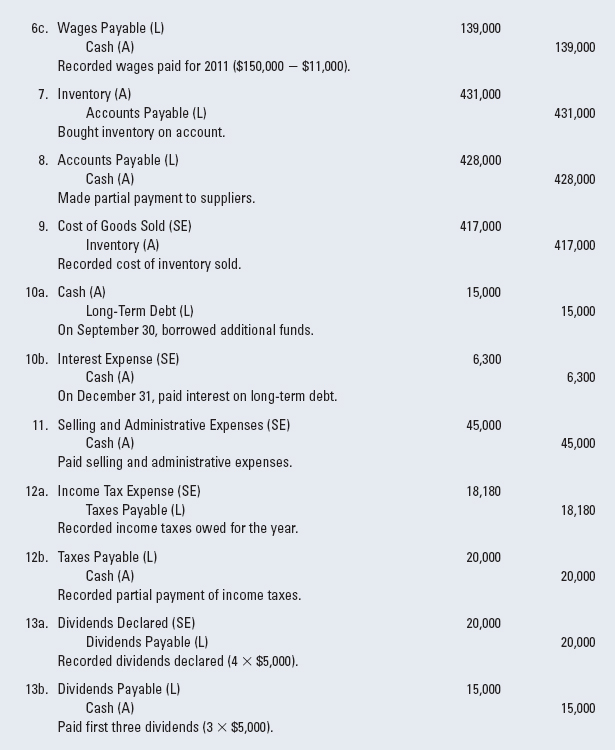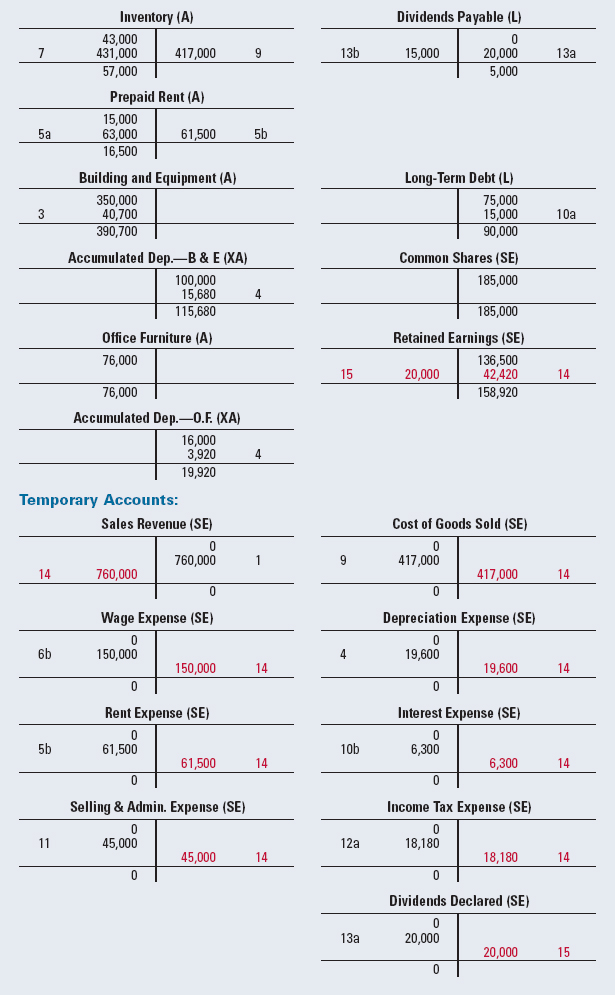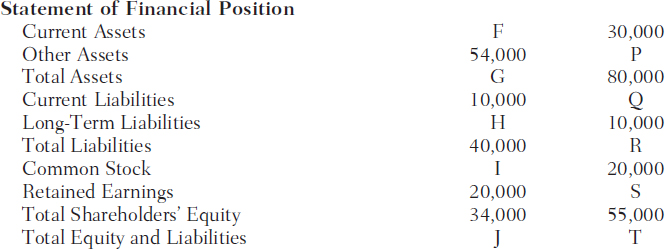chapter 3
PROCESSING DATA THROUGH THE ACCOUNTING SYSTEM
DOUBLE-ENTRY ACCOUNTING SYSTEMS
Statement of Financial Position
UNDERSTANDING THE ACCOUNTING CYCLE
Recording Transactions in a Journal
RECORDING IN JOURNAL, LEDGER, AND TRIAL BALANCE
Preparing an Adjusted Trial Balance
PREPARING FINANCIAL STATEMENTS AND CLOSING ENTRIES
LEARNING OBJECTIVES
After studying this chapter, you should be able to:
- Explain the role of debits and credits in the accounting system.
- Explain the difference between permanent and temporary accounts.
- Identify and explain the steps in the accounting cycle.
- Build a chart of accounts based on transactions that affect the company's assets, liabilities, and/or shareholder equity.
- Analyze transactions and record them in journal entry format.
- Post transactions from the journal to the ledger.
- Prepare a trial balance and use it to identify errors.
- Make adjusting entries to prepare an adjusted trial balance.
- Prepare financial statements.
- Explain closing entries and why they are necessary.
Learning to Handle the Dough
For generations, grandmothers in Grant Hooker's family would make a pastry of flattened, whole-wheat dough as a special treat, called a BeaverTail®, which became a Sunday staple with Mr. Hooker's own kids during the 1970s.
Mr. Hooker sold the family secret to the public for the first time in 1978, at a music festival near Killaloe, Ontario. The crowd loved it. The delectable dough was then served up at several Ottawa Valley agricultural fairs throughout that fall. Encouraged by the enthusiasm for his treats, Mr. Hooker, a builder by trade, trademarked the name “BeaverTails” and built his own booth in Ottawa's Byward Market in 1980 to sell them full-time. However, sales weren't as swift as at the fairs.
Undaunted, Mr. Hooker secured permission to sell BeaverTails on the Rideau Canal during Ottawa's Winterlude festival. “We had lineups down the lake,” he says. The whole family—Mr. Hooker's wife Pamela, and teenage son Nicholas and daughter Lisa—pitched in, giving out free samples and letting people know the treats were for sale year-round in the Market.
Within three years, BeaverTails Canada Inc. had the contract to sell all the food on the Rideau Canal and employed 450 people. The business continued to grow; BeaverTails began franchising in 1990 and now includes 97 locations across Canada, 2 in the United States, and 2 in the Kingdom of Saudi Arabia.
At first, keeping track of the money was straightforward and didn't require a formal accounting system. It meant little more than staying on top of how much was owed to suppliers and staff, and in rent and utilities. Mr. Hooker, who has no formal business training, got along fine simply managing the chequebook.
But this changed with franchising. “We weren't just selling products to people for cash, putting the cash in the bank, and then writing cheques for what we owed,” says Mr. Hooker. “We were into receivables; people owed us money.” The company also had liabilities—in the form of an operating loan from a bank.

Mr. Hooker hired an accountant to build the accounting system, working closely with him to learn how it worked. The breakthrough point for him, he says, was understanding that “cash is a debit on the balance sheet.” Assets (from the balance sheet) and expenses (from the statement of earnings) have normal debit balances. Liabilities and shareholders' equity (from the balance sheet) and revenues (from the statement of earnings) have normal credit balances. To increase the amount in an account, an entry has to be the same type as the balance, he adds. That is, debits increase debit accounts and credits increase credit accounts.
Now that he understands the basics of the accounting system, Mr. Hooker monitors it very closely. He insists that his accountant provide him with “TAMFS”—timely, accurate, monthly financial statements. “That is an absolute necessity any time a business grows to where the owner puts his trust in somebody else to handle the money,” he says. A lesson this entrepreneur learned as his business grew.
Now that you understand the basic accounting equation and can work through the analysis of some transactions, we are going to take you further into the practical side of accounting. We are going to show you how data is recorded in an accounting system so that organizations can easily extract information and summarize it into financial statements and other reports.
When you were working through Chapter 2, you used columns in tables to record the effects of transactions on the basic accounting equation. You could probably see that if you had to handle large volumes of accounts and transactions, this type of framework would become awkward to manage. Since real companies typically have hundreds of accounts and thousands of transactions, the accounting system for recording, summarizing, and reporting information about their economic activities requires something more elaborate than columnar tables.
USER RELEVANCE
Why is it important for users to have a good understanding of how accounting data are collected, stored, and reported? All business owners, such as Grant Hooker of BeaverTails, must understand how the financial statements reflect the company's business activities, especially if the owner intends to use the financial results to make decisions.
Investment analysts, who advise others on buying or selling shares, should also have in-depth knowledge of how an accounting system works. In order to understand what the numbers on financial statements mean, financial analysts need to know how the numbers are determined, and how relevant they are in understanding a company's overall profitability and financial position. Creditors, such as loan officers, need an in-depth understanding of the accounting process so that they can assess whether future cash flows will be adequate to meet the existing obligations, plus any future ones being contemplated. To do so, they need to understand what types of transactions affect which financial statement amounts.
Users should also be aware that decisions should not be made on single amounts or ratios. Rather, decision-makers should review the full set of results, because changes in one area of the financial statements will often have implications for other areas, which could affect the conclusions that are drawn.
DOUBLE-ENTRY ACCOUNTING SYSTEMS
The recording of transactions in a table or spreadsheet that has columns reflecting the basic accounting equation is sufficient if the entity has only a few transactions to record. This type of system is usually called a synoptic journal, and is used, for example, by community clubs that only need to maintain information about the dues they collect and the limited number of activities they undertake. However, using columnar tables or spreadsheets is cumbersome when large numbers of accounts and transactions are involved. To overcome this problem, accountants have developed a special system to record trans actions, which utilizes debits and credits and is known as the double-entry accounting system.
Before we introduce the role of debits and credits in an accounting system, we should point out that the method that we used to record transactions in Chapter 2 was a type of double-entry system, because each transaction affected two columns. In this way, we were able to keep the basic accounting equation in balance as each transaction was recorded. This principle also applies to double-entry accounting systems that use debits and credits rather than pluses and minuses, and that record the effects of transactions in accounts rather than columns.
LEARNING OBJECTIVE 1
Explain the role of debits and credits in the accounting system.
Debits and Credits
We will demonstrate the debit-credit system by using a simplified form of accounts, called T accounts. In the illustration below, notice that when this method is used to depict accounts the basic shape is a large letter T. Note also that the left side of a T account is known as the debit side, and the right side as the credit side.
GENERAL FORM OF A “T ACCOUNT”

Thus, at the most basic level, the words “debit” and “credit” in accounting simply refer to the left and right sides of an account. As you will soon see, whether an entry on the debit (left) or credit (right) side of an account indicates an increase or a decrease depends on the type of account involved.
The T account concept can be used for each specific asset, liability, and share-holders' equity account. Therefore, instead of the columns that we used for recording transactions in Chapter 2, from this point onward each asset, liability, and shareholders' equity item will have its own T account.
Regardless of the type of account (asset, liability, or shareholders' equity), items recorded on the left side are called debits and items recorded on the right side are called credits. However, note this key distinction: for asset accounts, the balances are debits (i.e., recorded on the left side of the account), while for liability and shareholders' equity accounts, the balances are credits (i.e., recorded on the right side of the account). This is the basic “rule” regarding debits and credits in accounting.
This allows us to express the balancing nature of the accounting system in terms of debits and credits, rather than in terms of the basic accounting equation. By recording asset balances on the left side of their accounts and liability and shareholders' equity balances on the right side of their accounts, we can maintain the basic accounting equation (i.e., Assets = Liabilities + Shareholders' Equity) by ensuring that the sum of all the debits in the accounts equals the sum of all the credits (i.e., Debits = Credits). If transactions are recorded correctly, in terms of debit entries and credit entries, the total debits will always equal the total credits and the accounting system will be “balanced.”
HELPFUL HINT
To remember which side of an account is the debit side and which is the credit side, think of the equation Debits = Credits. The word “Debits” is on the left side of this equation, and debit entries are always recorded on the left side of an account. Similarly, the word “Credits” is on the right side of the equation, and credit entries are always recorded on the right side of an account.
For example, Exhibit 3-1 shows how the balances for Demo Company at the end of January 2011 would be presented in T accounts. (As you probably recall, Demo Company was used to illustrate transactions in Chapter 2.) The accounts and balances are the same as those shown on Demo's statement of financial position for January 31, 2011, which was presented on page 105.
EXHIBIT 3-1 ACCOUNTS SHOWING THE BALANCES FOR DEMO COMPANY AS OF JANUARY 31, 2011
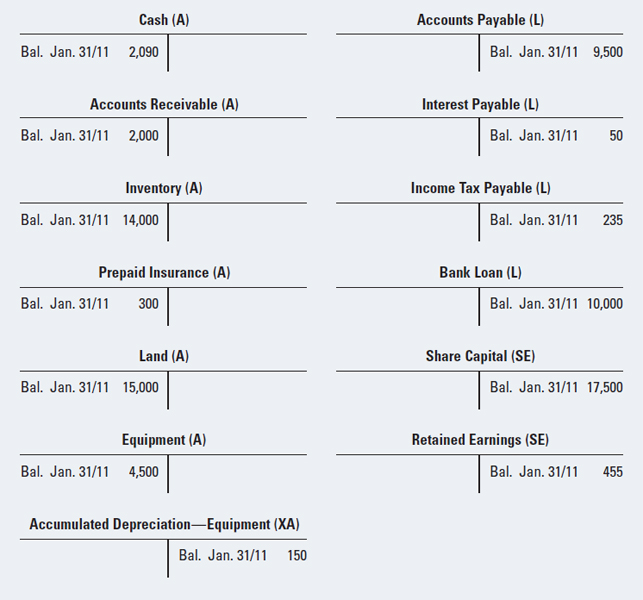
Notice the letters in the illustration, beside each of the account names. These letters will be used throughout this book to designate the type of account: (A) indicates an asset account, (L) a liability account, and (SE) a shareholders' equity account. These letters are intended to remind you of the type of account involved, and help you deal with it correctly.
HELPFUL HINT
To remember the sides on which different types of account balances should appear, think of the basic accounting equation (Assets = Liabilities + Shareholders' Equity). Assets are on the left side of this equation; hence, balances for assets are recorded on the left side of their T accounts. Similarly, liabilities and shareholders' equity are on the right side of the equation; hence, balances for liabilities and permanent shareholders' equity accounts are recorded on the right side of their T accounts.
In addition to these basic account categories, we will use (XA) to represent a contra-asset. At this point, we have only encountered one contra-asset, Accumulated Depreciation. However, other contra accounts will be introduced later. Remember that, when a statement of financial position is prepared, contra-assets are reported as deductions from their related assets. That is why the balance in Demo's contra-asset account, Accumulated Depreciation, is a credit while the balance in its related asset account, Equipment, is a debit. The fact that they are opposites indicates that one partially offsets the other.
Note that all of Demo's assets have debit balances, recorded on the left side of their T accounts, while all of its liabilities and shareholders' equity accounts have credit balances, recorded on the right side of their T accounts. Also remember that the accounting system ensures that Assets = Liabilities + Shareholders' Equity by keeping the total of the debit amounts equal to the total of the credit amounts.
We can now extend the basic rule regarding debits and credits, as follows:
- Because asset accounts have debit balances, increases in asset accounts are recorded as debits. It logically follows that decreases in assets are recorded as credits.
- Because liability and shareholders' equity accounts have credit balances, increases in liability and shareholders' equity accounts are recorded as credits. It logically follows that decreases in liabilities and shareholders' equity are recorded as debits.
Notice that asset accounts are treated in the opposite manner to liability and shareholders' equity accounts, in terms of debits and credits: debits increase assets, but decrease liabilities and shareholders' equity; credits increase liabilities and shareholders' equity, but decrease assets. Thus, whether the term “debit” or “credit” indicates an increase or decrease depends on the type of account.
Exhibit 3-2 illustrates the appropriate entries for asset, liability, and shareholders' equity accounts. This summarizes what are often referred to as “the rules of debit and credit.”
EXHIBIT 3-2 ENTRIES TO T ACCOUNTS:
A Summary of the Rules of Debit and Credit
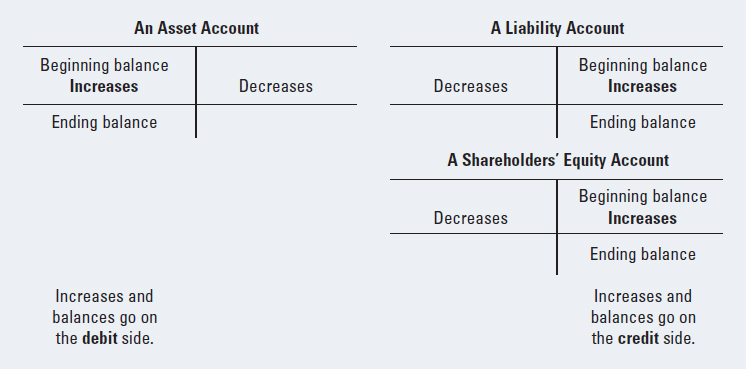
HELPFUL HINT
Remember that increases in accounts are recorded in the same way as the account balances:
- Asset account balances are debits; increases in assets are also recorded as debits.
- Liability and Shareholders' Equity account balances are credits; increases in liabilities and shareholders' equity are also recorded as credits.
The easiest way to remember these rules is to focus on how increases are recorded for each type of account. Logically, decreases are recorded on the opposite side of the account. Also, since there will be more increases than decreases (because you cannot take more out of an account than you put into it), account balances will be on the same side as the increases.
As you would expect, since contra-assets are deductions from their related assets, they are recorded in the same way as decreases in asset accounts (i.e., as credits). In terms of balances, since asset accounts have debit balances, it is logical that contra-asset accounts have the opposite (i.e., credit balances).
Statement of Financial Position
One way to think about the accounts and debits and credits is to imagine that the accounting system is a warehouse that is balanced on a central point (like the equal sign between the two parts of the basic accounting equation). In the warehouse, the company has boxes on both sides, which maintain the balance. The boxes themselves are weightless, which means you do not need to have the same number of boxes on each side. Weight is added when something is put in a box. Each box represents an account. When the company needs to keep track of information about a specific financial item, it creates a new box, and labels it so that everyone knows what is in that box. For example, there would be a box (or account) labelled Cash on one side of the warehouse and another labelled Share Capital on the other side.
As financial activities are recorded, things are added to or removed from the appropriate boxes. In order to preserve the balance, if you add something to an asset box on one side of the warehouse, you have to either take something out of another asset box, on the same side of the warehouse, or go to the other side of the warehouse and add something to one of the boxes there (a liability or a shareholders' equity box).
Debiting and crediting accounts is like putting things into boxes and taking things out. All the asset boxes are kept on the left side of the warehouse, and each time you add something to an asset box, you debit it; each time you take something out of an asset box, you credit it. All the liability and shareholders' equity boxes are on the right side of the warehouse, where the opposite is true. Each time you put something into a liability or shareholders' equity box, you credit it; each time you take something out, you debit it. If you are careful to ensure that every debit to a box is counterbalanced with a credit to another box, the warehouse will remain balanced. Periodically, you can check all the boxes to see what is in each one, and use this information to prepare a statement of financial position.
The accounts shown in Exhibits 3-1 and 3-2 are all statement of financial position accounts. Therefore, they have balances that carry over from one period to the next. (Recall that a statement of financial position shows what the entity has at that point in time, to be carried forward to future periods.) Therefore, statement of financial position accounts are sometimes called permanent accounts.
LEARNING OBJECTIVE 2
Explain the difference between permanent and temporary accounts.
One of the permanent accounts is retained earnings. You learned in Chapter 1 that the change in retained earnings during a given period is the increase or decrease due to the net income or loss (the difference between the revenues and expenses for the period) and the decrease due to the dividends declared. In order to keep track of the individual revenue and expense amounts, as well as the dividends declared during the period, the retained earnings account can be subdivided into several separate accounts. These separate accounts are called temporary accounts because they are used temporarily, during the accounting period, to keep track of the revenues, expenses, and dividends. At the end of the accounting period, the balances in the temporary accounts are transferred into the retained earnings account.
While revenues, expenses, and dividends declared are all shareholders' equity accounts, increases and decreases in them are handled differently. For revenues, credits represent increases (and debits represent decreases). For expenses and dividends declared, the opposite is true: debits represent increases (and credits represent decreases). The logic of this is directly connected to their effect on shareholders' equity: revenues increase shareholders' equity and thus are recorded as credits, while expenses decrease shareholders' equity and so are recorded as debits. Therefore, revenue accounts have credit balances, expense accounts have debit balances, and the dividends declared account has a debit balance (until these balances are eliminated when they are transferred to the retained earnings account at the end of the period).
Exhibit 3-3 shows the subdivision of the retained earnings account into the temporary revenue, expense, and dividends declared accounts.
EXHIBIT 3-3 RETAINED EARNINGS:
Revenues, Expenses, and Dividends Accounts
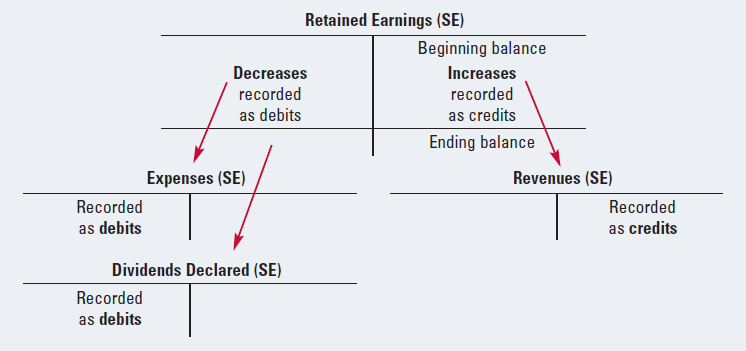
Notice that the rules of debit and credit for these accounts follow the overall rule for shareholders' equity: increases in shareholders' equity are recorded as credits, and decreases in shareholders' equity are recorded as debits. Therefore,
- since revenues increase the shareholders' equity, they are recorded as credits
- since expenses and dividends decrease shareholders' equity, they are recorded as debits.
Several other things should be noted about the revenue, expense, and dividends declared accounts.
First, at the beginning of each new accounting period, the balance in each of these accounts is always zero. Because these accounts are used to keep track of the revenues, expenses, and dividends declared during the current period, their beginning balances must be zero so that amounts from previous periods will not be combined with those of the current period.
At the end of each accounting period, the balance in each of the temporary revenue and expense accounts is used to prepare the statement of earnings, and is then transferred into the permanent retained earnings account, along with the dividends, to produce the ending balance in the retained earnings account.
HELPFUL HINT
- Increases in revenues are recorded as credits, and revenue accounts have credit balances.
- Increases in expenses are recorded as debits, and expense accounts have debit balances.
- Dividends declared are recorded as debits, and the dividends declared account has a debit balance.
In this way, the retained earnings account keeps track of the cumulative amounts of revenues and expenses less dividends, and the temporary accounts keep track of only the amounts for the current period. In other words, using our warehouse example, the contents of the revenue, expense, and dividends declared boxes are all dumped into the retained earnings box at the end of each period. A revenue box, with a credit balance, will increase the retained earnings (which also has a credit balance). An expense or dividends declared box, with a debit balance, will decrease the retained earnings.
The debit balances in the expense and dividends declared accounts are probably best understood by remembering that they both represent decreases in the shareholders' equity. Because shareholders' equity is represented by a credit balance, decreases in it must be represented by debit balances. At the end of the period, when the balances in the temporary accounts are transferred to retained earnings, the debit balances in the expense and dividends accounts will normally be offset by the credit balances in the revenue accounts, leaving the retained earnings account with an overall credit balance.
However, if expenses have exceeded revenues (i.e., the company has suffered losses), it is possible to have a debit balance in the retained earnings account. A debit balance in the retained earnings account indicates negative retained earnings, and is called a deficit. For example, if you look at the balance sheet (statement of financial position) of Ballard Power Systems Inc. in Exhibit 3-4, you will see that, rather than retained earnings, the company reported “accumulated deficit.” (Ballard Power Systems, with its head office, research and development, and manufacturing facilities in Burnaby, British Columbia, designs, manufactures, and sells fuel cells.) Most companies do not have deficits (i.e., negative amounts or debit balances in their retained earnings). However, it is not unusual for a company such as Ballard to have a deficit, as it is in the process of developing a new technology. It typically takes several years for companies to perfect such technologies to the stage where they can be commercialized widely and generate profits. In the meantime, losses are incurred and negative retained earnings are accumulated.
EXHIBIT 3-4 BALLARD POWER SYSTEMS INC. 2009 ANNUAL REPORT
BALLARD POWER SYSTEMS INC. 2009 ANNUAL REPORT


Animated Tutorials & Videos: Accounting Cycle Tutorial
UNDERSTANDING THE ACCOUNTING CYCLE
We are now ready to look at the whole system by which transactions are first measured, recorded, and summarized, and then communicated to users through financial statements. This system is called the accounting cycle because it is repeated each accounting period.
Exhibit 3-5 illustrates the complete cycle. Each of the steps will be discussed in the subsections that follow.
As we proceed through a discussion of the accounting cycle, we will demonstrate each stage by continuing the Demo Company example that we began in Chapter 2. In that chapter, we analyzed Demo's January transactions, recorded their effects in a columnar table, and used the table to prepare the company's financial statements for the month of January. In this chapter, we will use Demo's February transactions to explain how these would be handled in a formal accounting system and illustrate each of the steps in the accounting cycle.
A system for maintaining accounting records can be as simple as a notebook, in which everything is processed by hand, or as sophisticated as an on-line system in which most of the processing is done by computers. We will use a simple manual system to illustrate the accounting cycle. However, the same underlying processes apply to any accounting system, no matter how simple or sophisticated it is.
The Chart of Accounts
Imagine a company that has just been formed and whose managers need to set up an accounting system. One of the first things they must determine is what information they need to run the business. What information is important for them to make well-informed decisions? What information is needed by outside users? What is required to satisfy financial reporting standards? Accounting systems are information systems, so managers should decide at the outset what information they need in order to operate the business and satisfy the requirements of other users. These needs vary, so even companies in the same type of business will develop their own unique information systems and use different accounts.
EXHIBIT 3-5 THE ACCOUNTING CYCLE
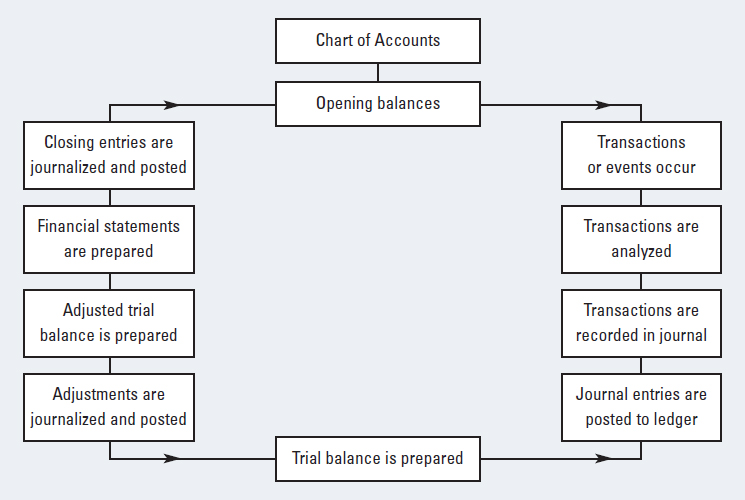
Once a company has decided what accounts it needs to have, in order to get the information that it requires, the types of accounting information to be recorded in the accounting system (represented by the accounts to be used) are generally summarized in a chart of accounts. The chart of accounts is the starting point for the company's accounting cycle. However, the chart of accounts is dynamic, rather than something that cannot be changed. As the business changes, it may need to have different types of accounts. For example, suppose that the company did not originally provide credit to its customers; all of its sales were for cash. In that case, there would have been no need for an accounts receivable account. Later, if the company decided to allow customers to buy on credit, it would need to add an accounts receivable account to its chart of accounts.
LEARNING OBJECTIVE 4
Build a chart of accounts based on transactions that affect the company's assets, liabilities, and/or shareholder equity.
Although there are certain account titles that are commonly used, an account can be given any name that makes sense to the company and describes the account's purpose. In an actual accounting system, each of the accounts in the chart of accounts would also be identified by a number that indicates the sequence of the accounts and makes it easier to record transactions in a computerized system. In this book, accounts will be designated by their names and not by account numbers.
EXHIBIT 3-6 DEMO COMPANY'S CHART OF ACCOUNTS
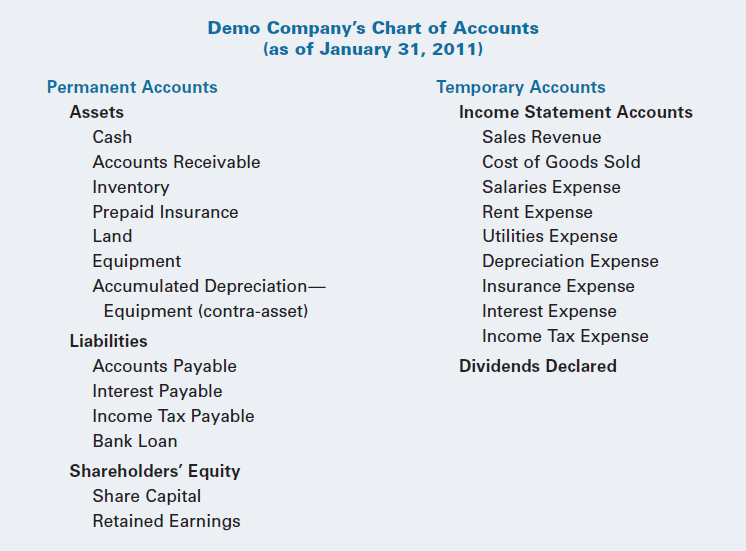
Exhibit 3-6 shows the chart of accounts for Demo Company, as of the end of January 2011. It consists of all the accounts that were used to record Demo's transactions in Chapter 2.
Later in this chapter, as we record Demo's February transactions, we will need to create some new accounts; as new accounts are created, they are added to the company's chart of accounts.
Notice that the accounts are listed in the chart of accounts in the order in which they will appear on the financial statements. Accounts are kept in this order so that it is easy to locate them in the ledger, and to facilitate the preparation of the financial statements. If account numbers are assigned to the accounts, a different set of account numbers will usually be assigned to each section of the financial statements. For example, many companies using four-digit account numbers will assign numbers between 1000 and 1999 to current assets only, so that all the accounts given those numbers will be easily identifiable as current assets. When the computer system prepares a statement of financial position, in the current assets section it will list these accounts in numerical order, according to the account numbers they were assigned.
The Opening Balances
As indicated in the chart of accounts, the permanent accounts are the statement of financial position accounts: assets, liabilities, and the main shareholders' equity accounts (at this stage, the share capital and retained earnings). The balances of the permanent accounts at the beginning of each accounting period are the amounts carried forward from the end of the previous accounting period. Exhibit 3-1 shows the opening balances in Demo's permanent accounts at the beginning of February 2011 (i.e., the amounts brought forward from its statement of financial position at the end of January, as determined in Chapter 2). Demo's temporary accounts at the beginning of February will all have zero balances, since every company starts each new accounting period with zero balances in its temporary accounts.
Exhibit 3-7 presents the complete set of Demo Company's accounts at the beginning of February 2011. Note that the balances in the permanent accounts are the same as those in Exhibit 3-1, and that the balances in all the temporary accounts are zero.
Note that there is a T account for each account listed in the chart of accounts (Exhibit 3-6). Also note that the temporary accounts for revenues, expenses, and dividends declared have been segregated from the permanent accounts, since only the permanent accounts have balances brought forward from the end of the previous accounting period.
TRANSACTIONS
The next step in the accounting cycle is to identify whether an event or transaction has occurred that affects the company's assets, liabilities, and/or shareholders' equity. If so, its effects on the company's accounts will have to be analyzed and recorded.
Evidence of a transaction or event is usually some sort of “source document”—a document that is received or created by the company indicating that something that needs to be recorded has happened. Examples of source documents include invoices, cheques, cash register tapes, bank deposit slips, and shipping documents.
EXHIBIT 3-7 DEMO COMPANY'S T ACCOUNTS, WITH BEGINNING BALANCES AS AT FEBRUARY 1, 2011
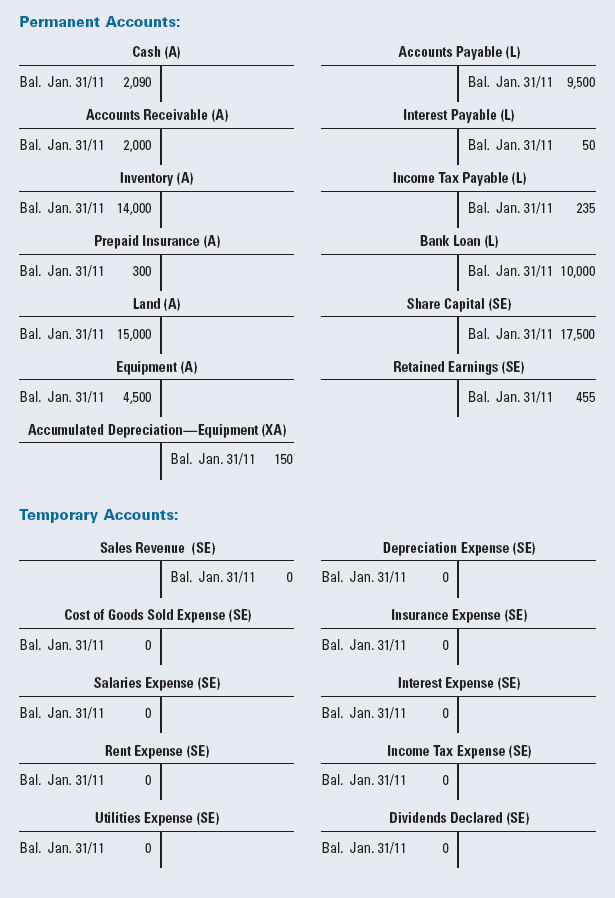
Analyzing Transactions
When a transaction or event has occurred, the accountant must analyze it to determine what accounts have been affected and how the transaction should be recorded in the accounting system. We introduced this phase of the process in Chapter 2, where we analyzed the effects of various transactions on the basic accounting equation and recorded the results by entering positive and negative amounts in a columnar table. In this chapter—and throughout the remainder of this book—we will analyze the effects of transactions to see how they should be recorded as debits and credits in a company's accounts.
Routine transactions, such as the purchase or sale of goods, need to be analyzed only once. After that, each subsequent purchase or sale transaction is handled in the same way and can be entered into the accounting system without further analysis. Unique and unusual transactions require special analysis, however, and sometimes require the services of a professional accountant who understands the use of appropriate accounting methods, according to generally accepted accounting principles, practices, and standards.
Recording Transactions in a Journal
After an accountant has decided how to record transactions, appropriate entries must be made in the accounting system. The initial entries are usually made in what is known as a journal. A journal is a chronological listing of all the events that are recorded in the accounting system. A journal could be as simple as a piece of paper on which a chronological list of the transactions that have occurred is recorded, but most organization's journals are now kept in computerized form. Each complete entry made in the journal shows the effects of a transaction or business event on the company's accounts, and is called a journal entry.
When entries are made to record transactions in a journal, they are always dated and often each of them is given a sequential entry number. Then, the names of the accounts affected by the transaction, and the amounts involved, are listed. The accounts being debited are listed first, followed by the accounts being credited, and the credit portions are indented. Finally, an explanation of the transaction is often included with the journal entry, for future reference.
To summarize the preceding paragraph, complete journal entries typically consist of the date and entry number, a listing of the names of the accounts affected (with their account numbers, if applicable), and the amounts being debited and credited, followed by a brief explanation. In this book, we will use the following format for presenting journal entries:
BASIC FORMAT FOR A JOURNAL ENTRY

As illustrated above, when journal entries are made the customary practice is to list the accounts that are being debited before the accounts that are being credited, and to indent the accounts that are being credited. Of course, each complete journal entry must keep the accounting system balanced; that is, the amount debited must equal the amount credited. (Accounting software generally contains internal subroutines that automatically check journal entries to ensure that they are balanced, and alert the user to any problems that must be fixed before proceeding.)
HELPFUL HINT
Accountants frequently use the abbreviation Dr. and Cr. for debit and credit, respectively (even though there is no “r” in “debit”).
We will now illustrate the process of analyzing transactions and recording them as journal entries by working through Demo's February transactions. Each transaction will be presented and analyzed, to determine what accounts are affected and whether they should be debited or credited. Then the journal entry to record the transaction will be presented. You should study this material carefully to ensure that you understand how the rules of debit and credit are applied and how journal entries are used to record transactions in an accounting system.
Transaction 1: Repayment of Loan
On February 1, 2011, Demo Company pays off $1,000 of the principal of its bank loan.
ANALYSIS Since Demo is paying off part of its bank loan, this liability account should be reduced. At the same time, the company is making a cash payment, so this asset account should be reduced.
Note that repaying the principal of a loan does not involve an expense. The expense associated with a loan is the interest charged on it, which is recorded separately.
ANALYSIS OF TRANSACTION 1
Liabilities (Bank Loan) decreased by $1,000
Assets (Cash) decreased by $1,000
These changes in the accounts are now translated into debits and credits. The rules of debit and credit specify that liability accounts have credit balances. Therefore, they are reduced by making debit entries. Accordingly, the liability account Bank Loan must be debited. Conversely, asset accounts have debit balances and therefore are reduced by making credit entries. Accordingly, the asset account Cash must be credited. Thus, this transaction is recorded in the journal as follows:
JOURNAL ENTRY FOR TRANSACTION 1

Transaction 2: Prepayment of Rent
On February 1, Demo Company signs a one-year lease agreement for office and storage space. The rent is to be $450 per month, and Demo pays the first and last months' rent (a total of $900) immediately. Thereafter, the monthly rent is to be paid on the first day of each month.
ANALYSIS Since the company is paying rent in advance, an asset is created (which would usually be called Prepaid Rent). At the same time, the company is making a cash payment, so this asset account should be reduced.
Like insurance, which is also paid in advance (discussed in Chapter 2), rent should not be recorded as an expense until the cost has expired (been used up). This is why rent expense is not recorded at this time.
ANALYSIS OF TRANSACTION 2
Assets (Prepaid Rent) increased by $900
Assets (Cash) decreased by $900
We now translate these changes into debits and credits for the journal entry. The rules of debit and credit specify that asset accounts have debit balances. Therefore, they are increased by making debit entries, and decreased by making credit entries. Accordingly, the asset account Prepaid Rent must be debited, and the asset account Cash must be credited. Thus, this transaction is recorded in the journal as follows:
JOURNAL ENTRY FOR TRANSACTION 2

Transaction 3: Purchase of Inventory on Account
On February 5, the company buys $30,000 of additional inventory on account.
ANALYSIS As we saw in Chapter 2, when goods are purchased to be sold in the future, the asset Inventory is increased. At the same time, since the purchase is on account and payment will not be made until later, the liability Accounts Payable is increased.
ANALYSIS OF TRANSACTION 3
Assets (Inventory) increased by $30,000
Liabilities (Accounts Payable) increased by $30,000
We now translate these changes in the accounts into debits and credits. The rules of debit and credit specify that asset accounts have debit balances, and are therefore increased by making debit entries. Conversely, liability accounts have credit balances, and are increased by making credit entries. Accordingly, the asset Inventory must be debited, and the liability Accounts Payable must be credited. Thus, this transaction is recorded in the journal as follows:
Transaction 4: Sales for Cash and on Account
On February 8, the company sells goods to customers for $40,000. Of these sales, $4,000 are for cash; the remaining $36,000 are on account.
ANALYSIS When goods are sold to customers, the company's assets are increased and revenue is earned, equal to the selling price of the goods that have been sold—i.e., the amount that is received, or will be received, from the sale. In this case, the assets Cash and Accounts Receivable are increased by $4,000 and $36,000, respectively, and revenue of $40,000 is recognized. (Remember that, under the accrual basis of accounting, revenue is generally recognized when the sale is made, not when the cash is collected.) Because it affects the net earnings and, ultimately, the retained earnings, revenue is a shareholders' equity account.
ANALYSIS OF TRANSACTION 4
Assets increased by $40,000 (Cash of $4,000 and Accounts Receivable of $36,000)
Shareholders' Equity increased by $40,000 (recorded as Sales Revenue)
These changes in the accounts are now translated into debits and credits. Assets are increased by making debit entries. Accordingly, the asset accounts Cash and Accounts Receivable must both be debited. Conversely, the rules of debit and credit specify that shareholders' equity is increased by making credit entries. Therefore, the Sales Revenue account must be credited. Thus, this transaction is recorded in the journal as follows:
JOURNAL ENTRY FOR TRANSACTION 4

Notice that the above journal entry has three parts. However, the sum of the two debit parts (4,000 and 36,000) is equal to the credit part (40,000), so the entry as a whole is in balance. This illustrates the fact that, although every journal entry must have at least one debit and one credit, a journal entry can have any number of debit and credit parts, as long as the sum of the amounts debited is equal to the sum of the amounts credited. The term compound journal entry is used for a journal entry that has more than two parts.
Transaction 5: Cost of Goods Sold
The company determines that the cost of the goods that were sold on February 8 is $27,000.
ANALYSIS As you should recall from Chapter 2, when goods are sold their cost must be removed from the asset account Inventory and transferred to the expense account Cost of Goods Sold. In other words, in addition to the revenue that is earned when a sale is made, the company's assets are decreased and an expense is incurred, equal to the cost of the goods that have been sold. In this case, the asset Inventory is decreased by $27,000 and an expense of the same amount is recognized. Because they affect the net earnings and, ultimately, the retained earnings, expenses are shareholders' equity accounts.
ANALYSIS OF TRANSACTION 5
Shareholders' Equity decreased by $27,000 (recorded as Cost of Goods Sold)
Assets (Inventory) decreased by $27,000
We now translate these changes into debits and credits for the journal entry. Shareholders' equity is decreased by making debit entries. Therefore, the Cost of Goods Sold account must be debited. At the same time, since assets are decreased by making credit entries, the Inventory account must be credited. Thus, this transaction is recorded in the journal as follows:
JOURNAL ENTRY FOR TRANSACTION 5

Transactions 4 and 5 are logically linked, because when goods are sold the company's assets are increased and revenue is earned (equal to the selling price of the goods that have been sold), and at the same time the company's assets are decreased and an expense is incurred (equal to the cost of the goods that have been sold). Subtracting the expense from the revenue reveals the amount of profit made on the sale. In this case, goods costing $27,000 were sold for $40,000, resulting in a gross profit of $13,000. This is referred to as gross profit because there are many other expenses—salaries, rent, utilities, etc.—that have to be deducted to determine the company's net profit or earnings for the period. (In accounting, the term “gross” is generally used to refer to the initial amount of an item, before certain deductions from it have been made; and the term “net” is used to refer to the final amount of an item, after the deductions from it have been made.)
Transaction 6: Purchase of Supplies for Cash
On February 10, Demo Company buys office supplies for $500 cash.
ANALYSIS Whenever something is purchased to be used in the future, it should be recorded as an asset. We will refer to this asset account as Office Supplies on Hand. Since cash is paid for the purchase, the asset account Cash is decreased.
Note that, since these office supplies will be used in the future operations of the business, there is no expense recorded at this point. Eventually, when the supplies are consumed, their cost will be transferred to an expense account; however, as long as they are on hand they are an asset. This is similar to the treatment of merchandise inventory, prepaid insurance, and prepaid rent.
ANALYSIS OF TRANSACTION 6
Assets (Office Supplies on Hand) increased by $500
Assets (Cash) decreased by $500
We now translate these changes in the accounts into debits and credits. The rules of debit and credit specify that asset accounts have debit balances, and are therefore increased by making debit entries and decreased by making credit entries. Accordingly, the asset Office Supplies on Hand must be debited, and the asset Cash must be credited. Thus, this transaction is recorded in the journal as follows:
JOURNAL ENTRY FOR TRANSACTION 6

Transaction 7: Purchase of Equipment for Cash
On February 12, the company buys additional equipment for $3,000 cash.
ANALYSIS This is similar to Transaction 6. Equipment is purchased to be used in the future, so the asset Equipment is increased. At the same time, since it is a cash purchase, the asset Cash is decreased.
As with the office supplies in Transaction 6, the equipment will be used in the future operations of the business. Therefore, at this point it is an asset. Eventually, however, as the value of the equipment is consumed, its cost will have to be transferred to an expense account. For long-term assets like equipment, whose benefits are used up gradually over many accounting periods, this is done through the process of depreciation (discussed in Chapter 2).
Asset accounts have debit balances, and are therefore increased by making debit entries and decreased by making credit entries. Accordingly, the asset Equipment must be debited, and the asset Cash must be credited. Therefore, this transaction is recorded in the journal as follows:
JOURNAL ENTRY FOR TRANSACTION 7

Transaction 8: Issuance of Shares for Cash
On February 15, shareholders invest an additional $5,000 cash in the business.
ANALYSIS As we saw in Chapter 2, when people invest cash in a business they are issued shares in the company, as evidence of their investment. Consequently, the company has an increase in its assets, in the form of Cash, and an increase in its shareholders' equity, in the form of Share Capital.
ANALYSIS OF TRANSACTION 8
Assets (Cash) increased by $5,000
Shareholders' Equity (Share Capital) increased by $5,000
Assets are increased by making debit entries. Accordingly, the asset account Cash must be debited. Conversely, the rules of debit and credit specify that shareholders' equity is increased by making credit entries. Therefore, the Share Capital account must be credited. Thus, this transaction is recorded in the journal as follows:
JOURNAL ENTRY FOR TRANSACTION 8

Transaction 9: Collections from Customers on Account
On February 18, Demo collects all but $5,000 of the amounts due from its customers.
ANALYSIS Notice that the amount given in the description of this transaction is not the amount of cash that was collected. Rather, it is the amount that was not collected; in other words, it is the ending balance of accounts receivable.
This illustrates an important difference in the type of information you may be given regarding a transaction, which you will encounter in some cases. Rather than simply being given the amount of the transaction, you may be given the remaining balance in a related account. In such cases, you will have to use the given information to logically determine the amount to be recorded in the journal entry.
In this case, in order to prepare the journal entry for this transaction we need to determine the amount of cash that was collected. This can be done by using the following relationships:

As discussed in Chapter 2, when a company receives payments from its customers on account, one asset (Cash) increases and another asset (Accounts Receivable) decreases. No revenue is recognized when cash is collected on account, because under the accrual basis of accounting the revenue is recognized when the sale is made, not when the cash is collected.
ANALYSIS OF TRANSACTION 9
Assets (Cash) increased by $33,000
Assets (Accounts Receivable) decreased by $33,000
Asset accounts have debit balances, and are therefore increased by making debit entries and decreased by making credit entries. Accordingly, the asset Cash must be debited, and the asset Accounts Receivable must be credited. Thus, this transaction is recorded in the journal as follows:
JOURNAL ENTRY FOR TRANSACTION 9

Note again that the $5,000 given in the description of this transaction does not appear in the journal entry. Rather, since it was a balance, it was used to calculate the $33,000 recorded in the above entry. From this point onward, you will have to watch for situations like this, in which you are given information about the balance in an account, rather than the amount of a particular transaction. In these cases, you will need to bear in mind that a balance is not recorded with a journal entry; a balance is the net amount remaining in an account, as a result of all the preceding transactions affecting that account. Therefore, if you are trying to record a transaction but are given information regarding the balance in an account, you will need to use it—together with your knowledge of the logical relationships affecting that account—to calculate the amount to be recorded in the journal entry, as we did for this transaction. We will see more examples of this process in later transactions.
Transaction 10: Payments to Suppliers on Account
On February 20, Demo Company makes payments of $34,000 on its accounts payable.
ANALYSIS As we discussed in Chapter 2, when a company pays for previous purchases on account, both its liabilities (Accounts Payable) and its assets (Cash) are reduced.
ANALYSIS OF TRANSACTION 10
Liabilities (Accounts Payable) decreased by $34,000
Assets (Cash) decreased by $34,000
Liabilities have credit balances, and are therefore decreased by making debit entries. Accordingly, the liability Accounts Payable must be debited. Conversely, assets have debit balances, and are therefore decreased by making credit entries, so the Cash account must be credited. Thus, this transaction is recorded in the journal as follows:
JOURNAL ENTRY FOR TRANSACTION 10

Transaction 11: Salaries Expense
On February 25, the company pays $2,500 for salaries. In addition, it still owes $300 to employees for time worked during February, which will be paid in March.
ANALYSIS According to the accrual basis of accounting, the amount of salaries expense that should be recorded each period is the amount that is incurred that period, rather than simply the amount that is paid during the period. Therefore, the amount of salaries expense to be recorded for the month of February is $2,500 + $300 = $2,800.
It should be noted that Demo did not have any salaries payable at the end of January. (This can be confirmed by checking the balances in Exhibit 3-7.) If there had been salaries payable at the beginning of February (i.e., brought forward from January), this amount would have been deducted in the calculation above. This is because, if you are calculating the amount of salaries expense to be recorded for the month of February, any salaries paid during February for the month of January should be excluded from the February expense.
Since expenses reduce net income and, ultimately, retained earnings, the salaries expense causes a decrease in shareholder's equity. At the same time, assets (in the form of Cash) are decreased by the amount paid, and liabilities (in the form of Salaries Payable) are increased by the amount owing.
ANALYSIS OF TRANSACTION 11
Shareholders' Equity decreased by $2,800 (recorded as Salaries Expense)
Assets (Cash) decreased by $2,500
Liabilities (Salaries Payable) increased by $300
Shareholders' Equity is decreased by making debit entries. Therefore, since expenses are temporary shareholders' equity accounts, the Salaries Expense account must be debited. Because assets are decreased by making credit entries, the Cash account must be credited. Since liabilities are increased by making credit entries, the Salaries Payable account must also be credited. Thus, this transaction is recorded in the journal as follows:
JOURNAL ENTRY FOR TRANSACTION 11

This is another example of a compound journal entry. Note that although it has two credits and only one debit, the amount debited equals the total amount credited.
Transaction 12: Declaration of Dividends to Be Paid Later
On February 28, dividends of $400 are declared. However, they will not be paid to the shareholders until March.
ANALYSIS Dividends have to be recorded as soon as they are declared. If they are not paid immediately, the declaration creates a legal obligation for the company to make the payment later, which means that a liability has to be recorded.
Dividends reduce shareholder's equity, by reducing the amount of retained earnings. They are usually recorded in a temporary account called Dividends Declared. At the same time, if they are not paid they increase liabilities (in the form of Dividends Payable) by the amount owing.
ANALYSIS OF TRANSACTION 12
Shareholders' Equity decreased by $400 (recorded as Dividends Declared)
Liabilities (Dividends Payable) increased by $400
Shareholders' Equity is decreased by making debit entries. Therefore, the temporary shareholders' equity account called Dividends Declared is debited. At the same time, since liabilities are increased by making credit entries, the Dividends Payable account must be credited. Accordingly, this transaction is recorded in the journal as follows:
JOURNAL ENTRY FOR TRANSACTION 12

This completes Demo Company's transactions for February. Exhibit 3-8 shows the company's journal at this stage, with all the transactions recorded in it. The first four journal entries have been colour-coded for easy reference in the following section, which illustrates the posting process.
LEARNING OBJECTIVE 6
Post transactions from the journal to the ledger.
RECORDING IN JOURNAL, LEDGER, AND TRIAL BALANCE
Posting to the Ledger
Although the journal provides an important chronological record of the effects of each transaction on the accounts, the information in the journal is not organized in a way that is very useful for most purposes. For example, if a manager wanted to know the balance in the cash account, the accountant would have to take the beginning balance of cash and add or subtract all the journal entries that affected cash. To prepare financial statements, the accountant would have to go through this process for all of the accounts, in order to determine their ending balances. If the company had hundreds of journal entries, this would be extremely time-consuming and inefficient. Therefore, to provide more efficient access to information about the cumulative effects of transactions on individual accounts, the next step in the accounting cycle transfers the data in the journal to the accounts in the ledger. This process is called posting.
The ledger is the collection of all the accounts used by a company. Posting is the process of transferring the information from the journal entries to the ledger accounts.
Each account in the ledger represents a separate, specific T account, and includes the name of the account (and its number, if applicable), its beginning balance, and then a listing of all the postings that affected the account during the period. Each posting includes the date of the transaction and the transaction number, as well as the amount debited or credited. The date and transaction number enable users to cross-reference the amounts in the ledger with the related entries in the journal, and thus determine the source of each of the amounts that has been posted to the accounts.
EXHIBIT 3-8 DEMO COMPANY'S JOURNAL SHOWING ITS TRANSACTION ENTRIES FOR THE MONTH OF FEBRUARY
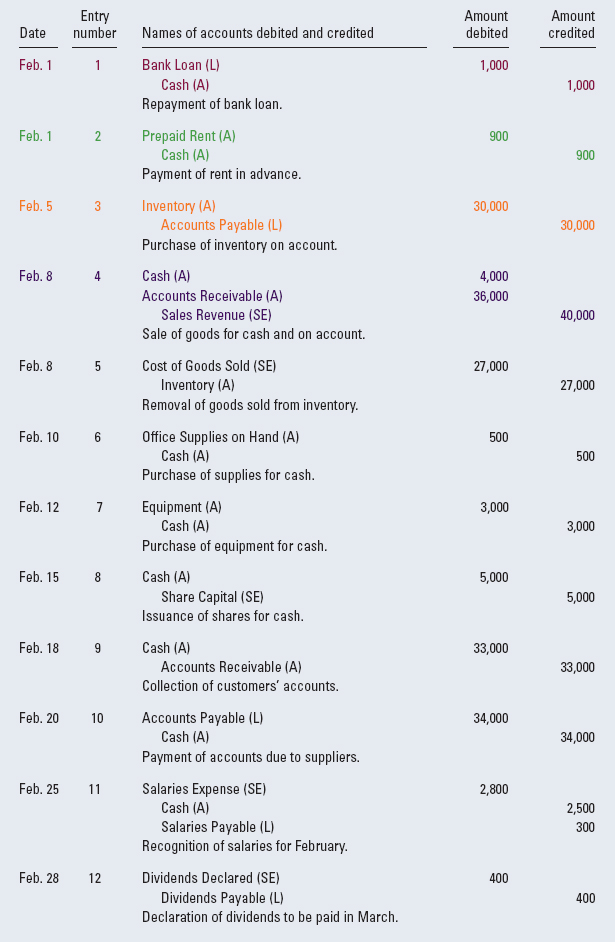
Exhibit 3-7 presented Demo Company's ledger accounts before the February transactions were posted, while Exhibit 3-9 shows its ledger after the February transactions have been posted. Four new accounts have been added (Prepaid Rent, Office Supplies On Hand, Salaries Payable and Dividends Payable), because we needed them to record new types of transactions that occurred in February. These new accounts would also be added to the company's chart of accounts, which was presented in Exhibit 3-6.
To make it easier to see how the posting process transfers the information from the journal (Exhibit 3-8) to the accounts in the ledger (Exhibit 3-9), the first four entries in the journal have been colour-coded to match the related postings in the ledger. For example, in Exhibit 3-8 the journal entry on February 1 for Transaction 1 indicates that the Bank Loan account is to be debited $1,000 and the Cash account is to be credited $1,000. In Exhibit 3-9, you will see that $1,000 has been posted as a debit to the Bank Loan account, by entering it on the left side of that T account; $1,000 has also been posted as a credit to the Cash account, by entering it on the right side of that T account; and both have been cross-referenced to the journal by the notation “Trans. #1, Feb. 01/11.”
Similarly, in Exhibit 3-8 the journal entry on February 1 for Transaction 2 indicates that the Prepaid Rent account is to be debited and the Cash account is to be credited, in the amount of $900. In Exhibit 3-9, you will see that $900 has been posted as a debit to the Prepaid Rent account (by entering it on the left side of that T account) and as a credit to the Cash account (by entering it on the right side of that T account), and both have been cross-referenced to the journal by the notation “Trans. #2, Feb. 01/11.”
You should follow this same process to see how the journal entries for Transactions 3 and 4, shown in Exhibit 3-8, have been transferred to the T accounts in the ledger in Exhibit 3-9. Once you have traced these amounts from their origins in the journal to their individual accounts in the ledger, you should have a good understanding of what “posting” means. It is a mechanical process, and all of the entries in the journal are transferred to the accounts in the ledger in the same way.
Posting to the ledger can be done monthly, weekly, daily, or at any frequency desired. The timing of the postings is determined to some extent by management's (or the shareholders') need for up-to-date information. If managers need to know the balance in a particular account, say Cash, on a daily basis, then the postings have to be done at least daily. If management needs to know the amount of cash available on an hourly basis, then the postings have to be done at least hourly.
Many computer systems account for transactions in “real time,” meaning that accounts are updated instantaneously, as each transaction occurs. Once a journal entry has been completed, such systems automatically post the information to the ledger accounts. Other computer systems collect journal entries in batches and post them all at one time (for example, at the end of each day). In general, since managers like to have information sooner rather than later, the number of real-time accounting systems continues to increase as the cost of computer technology continues to decrease.
At this point, it is important to note that a system consisting only of journal entries would make it difficult for managers to know the balances in the accounts. On the other hand, a system of only ledger accounts, without the original journal entries, would make it difficult to understand the sources of the amounts in the accounts. Accounting systems need both journal entries and ledger accounts in order to collect information in a way that makes it readily accessible and as useful as possible.
EXHIBIT 3-9 DEMO COMPANY'S LEDGER AFTER THE FEBRUARY TRANSACTIONS HAVE BEEN POSTED TO IT
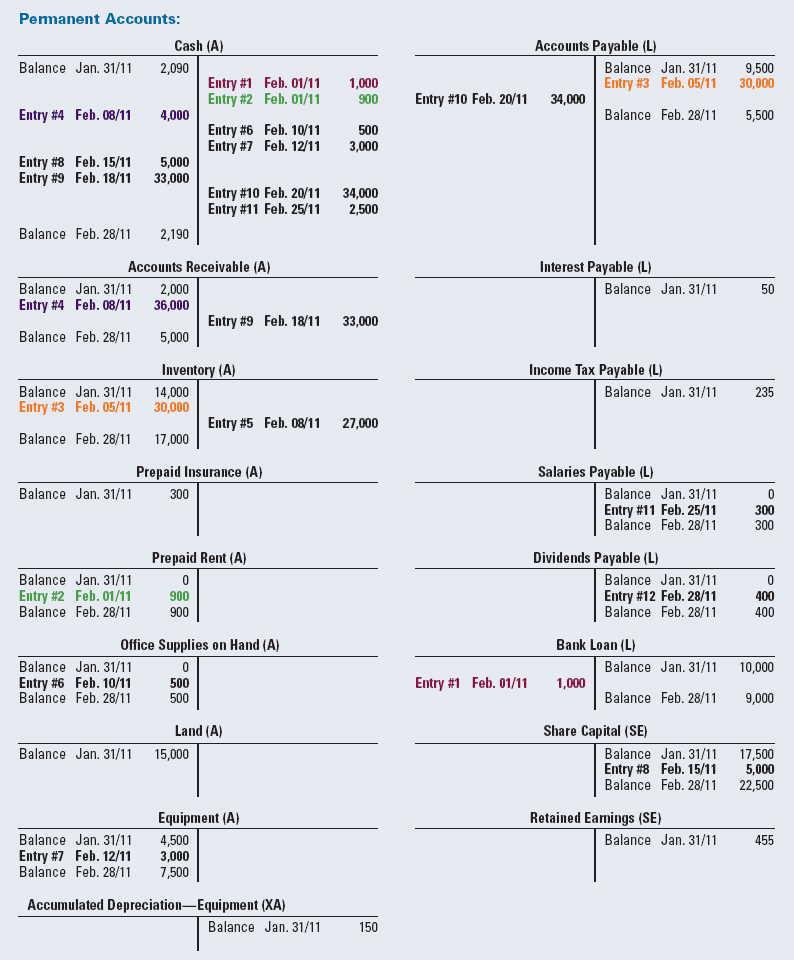
Finally, it should be noted that, since each journal entry must have equal debits and credits, if the journal entries are posted properly, the ledger should always be in balance (i.e., the total of the debit amounts in the accounts should be equal to the total of the credit amounts).
LEARNING OBJECTIVE 7
Prepare a trial balance and use it to identify errors.
Preparing a Trial Balance
While most errors should be detected at the journal entry and posting phases of the accounting cycle, some errors may persist. As stated earlier, most computerized systems will not post a journal entry unless the debits equal the credits. These systems catch most errors at the input stage. In manual systems, however, errors may not be detected when journal entries are being made. Moreover, even if the debits equal the credits at the journal entry stage, it is possible for the amounts to be posted incorrectly to the accounts. A useful tool for detecting errors in the ledger is to produce a trial balance.
The trial balance is a listing of all the account balances in the ledger at a specific point in time. To use our warehouse example, we would look into each of the boxes and make a list of the final amount in each of them. A check can then be done to ensure that the total of all the balances on the debit side equals the total of all the balances on the credit side. If these amounts are not equal, a mistake has been made at some point during the process and it must be found and corrected before proceeding.
Notice in Exhibit 3-9 that, in addition to the February transactions having been posted, the ending balance in each account has been calculated (except for those accounts, such as Land, that were not affected by any transactions during the period). The account balances are found by simply adding the debit amounts and subtracting the credit amounts, or vice versa. For example, the balance in the Cash account can be found by adding the debits and subtracting the credits: 2,090 + 4,000 + 5,000 + 33,000 − 1,000 − 900 − 500 − 3,000 − 34,000 − 2,500 = 2,190. Note that, since Cash is an asset account, the balance is a debit. Similarly, the balance in the Accounts Payable account can be found by adding the credits and subtracting the debit: 9,500 + 30,000 − 34,000 = 5,500. In this case, since Accounts Payable is a liability account, the balance is a credit.
HELPFUL HINT
Do not confuse a trial balance with a balance sheet. A trial balance lists the balances in all the accounts, while a balance sheet (statement of financial position) includes only the asset, liability, and permanent shareholders' equity accounts.
Exhibit 3-10 illustrates a trial balance, using the data presented in Exhibit 3-9.
Notice the order of the accounts in the ledger, and hence in the trial balance. The permanent accounts are presented first (in the same order as they will appear on the statement of financial position), followed by the temporary accounts (the revenues, expenses, and dividends). This makes it easier to prepare the financial statements. Also, note that although the accumulated depreciation account has a credit balance, it is not a liability; it is a contra-asset account, representing the portion of the equipment's cost that has been used up and written off, through depreciation, thus far.
EXHIBIT 3-10 DEMO COMPANY'S TRIAL BALANCE AS OF FEBRUARY 28, 2011 (before adjustments)

HELPFUL HINT
If you prepare a trial balance that does not balance, here are some tips for finding your error:
- First, calculate the difference between the total debits and the total credits, and look for this amount in either the question or your answer.
- Divide the difference from the first step by 2, and check to see whether a debit for this amount has been recorded as a credit, or vice versa.
- Divide the difference from the first step by 9. If it divides evenly—with no decimals—check for a transposition error: two digits that have been reversed (for example, 765 written as 756, or 432 written as 234).
The purpose of a trial balance is to assist in detecting errors that may have been made in the recording process. If the ledger does not balance (i.e., if the total of all the debit balances in the accounts does not equal the total of all the credit balances), this indicates that something is wrong. In such cases, there is no point in proceeding until the errors have been found and corrected. This makes the preparation of a trial balance a very useful step in the accounting cycle. However, it is important to realize that, because a trial balance only checks whether the total of the debit balances in the ledger accounts equals the total of the credit balances, it cannot detect all types of errors. For example:
- The trial balance will still balance if the correct amount was debited or credited, but to the wrong account (for example, if a purchase of office supplies was debited to the Inventory account, rather than to the Office Supplies account).
- If an incorrect amount was recorded (for example, if a $450 transaction was recorded as a $540 transaction, for both the debit and credit portions of the entry), the trial balance will still balance.
- The trial balance will also not detect the complete omission of an entire journal entry. If neither the debit nor the credit portions of a journal entry were posted, the totals on the trial balance will still be equal.
Despite these limitations, the preparation of a trial balance is very helpful in detecting many other types of common errors in the recording process, and is an important step in the accounting cycle.
LEARNING OBJECTIVE 8
Make adjusting entries to prepare an adjusted trial balance.
Recording Adjusting Entries
If an error is detected in the trial balance phase, it must be corrected. A journal entry to correct an error is one type of adjusting entry that is made at the end of the accounting period. A second, routine type of adjusting entry is made for accounting events that were not recognized and recorded during the period. These reflect the objective of the adjusting entry phase of the accounting cycle: to ensure that all the appropriate revenues and expenses have been recorded and reported for the period. Common examples of adjustments that must be made at the end of an accounting period are recording the depreciation of capital assets, recognizing the portions of prepaid expenses that have expired, recording interest and other accrued liabilities, recognizing the cost of supplies that were used up during the period, and recording income taxes. We introduced some basic adjustments in Chapter 2; in this chapter, we will continue our discussion of adjustments and demonstrate how the appropriate journal entries are made.
Notice that the types of items that need to be adjusted generally relate to the passage of time: the depreciation of capital assets, the expiration of prepaid expenses, the accrual of interest, and the consumption of supplies all occur on a daily basis. However, because recording them every day would be impractical, they are typically updated only at the end of the accounting period, through adjusting entries. In most situations there is no external transaction at the end of a period to signal that an adjustment needs to be made—only the passage of time. As a result, the ending balances in the accounts have to be carefully reviewed to determine those that need to be adjusted.

Ethics in Accounting

Many adjusting entries require management to make estimates and exercise judgement, providing opportunities for managers to manipulate earnings and statement of financial position values.
For example, suppose that you, as an accountant for a company, are asked to postpone the write-off of some old equipment. The equipment has not been used for some time, and it is clear to you that it will never be used again. You therefore think that it should be written off immediately. However, the write-off would need to be recognized as a loss (like an expense on the statement of earnings) and, since the amount involved is large, it would have a significant negative impact on the company's income for the period. Management has asked you to postpone the write-off because the company has applied for a large loan from the bank, and the loss from the write-off would have a negative impact on the bank's assessment of the company. What should you do?
As you consider your response to this, or any, ethical question, it is sometimes helpful to think about who will be affected by your decision (including yourself), and how it will help or hurt them. Particularly, think of who the users or potential users of the financial statements are, and how they might be affected by your action (or inaction). This should help you structure a fuller understanding of the situation and make an ethical decision.
It is essential that financial statements not be presented in a way that could mislead, or potentially harm, a user—such as the bank, in this case.
Under the accrual basis of accounting, companies must apply the revenue recognition principles (introduced in Chapter 2 and discussed in detail in Chapter 4) to ensure that all the revenues earned in an accounting period are identified, recorded, and reported in that period. They must also apply the matching principle to ensure that all the expenses incurred to generate those revenues are identified, recorded, and reported in that period. Therefore, in order to properly measure a company's net income and financial position, end-of-period adjustments to the revenues and expenses, and to the related assets and liabilities, are an essential step in the accounting cycle.
As stated earlier, end-of-period adjustments are very important. They ensure that all events and transactions related to the period have been accounted for, and thus make the financial statements as accurate as possible. We will illustrate the adjusting process by working through Demo Company's adjustments as of February 28, 2011.
At the end of February, Demo's accountant reviews the accounts in the trial balance and notes that adjustments need to be made for interest, rent expense, office supplies, utilities, depreciation, insurance, and income tax. This is a fairly typical set of adjustments, so we will now analyze each of these items and prepare the appropriate adjusting journal entries.
Entry 13: Interest Adjustment
Interest on the company's bank loan must be recognized for the month of February. (As noted in Chapter 2, the loan originated on January 1 and has an interest rate of 6% per year. However, the interest does not have to be paid until the end of March.)
ANALYSIS From the borrower's point of view, interest is an expense and therefore causes a decrease in shareholders' equity in the period when it is incurred. Since Demo is preparing financial statements each month, the interest for January was recognized at the end of January (in Chapter 2); the interest to be recognized now is only for the month of February. Since the company has not yet paid the interest (because it is not due to be paid until the end of March), it has to recognize a liability for its obligation to pay the interest later.
Recall that Demo Company paid off $1,000 of its bank loan on February 1 (see Transaction 1), which reduced the principal amount from $10,000 to $9,000. This can be confirmed by looking at the amount shown for the Bank Loan on the trial balance in Exhibit 3-10. To calculate the amount of interest expense for February, the principal amount of the loan is multiplied by the interest rate and the fraction of the year that has passed. In this case, the amount of interest incurred in February is $9,000 × 6% × 1/12 = $45. Shareholders' equity (retained earnings) will therefore be decreased by $45, as a result of the interest expense, and a liability (interest payable) will be increased by the same amount, to recognize the obligation to pay this interest when it is due at the end of March.
ANALYSIS OF INTEREST ADJUSTMENT
Shareholders' Equity decreased by $45 (recorded as Interest Expense)
Liabilities (Interest Payable) increased by $45
The rules of debit and credit specify that shareholders' equity is decreased by making debit entries. Accordingly, the Interest Expense account must be debited. Conversely, liabilities are increased by making credit entries, so the Interest Payable account must be credited. Thus, this adjustment is recorded in the journal as follows:
JOURNAL ENTRY FOR INTEREST ADJUSTMENT

Entry 14: Rent Adjustment
Rent expense must be recognized for the month of February.
ANALYSIS From the tenant's point of view, rent is an expense and therefore causes shareholders' equity to decrease in the period when it is incurred. Since Demo Company is operating on a monthly accounting cycle, the rent expense to be recognized at this point is only for February.
Recall that Demo signed a lease agreement on February 1 and paid $900 to cover the first and last months' rent, which was recorded as an asset called Prepaid Rent (see Transaction 2). This can also be seen by looking at the amount shown for Prepaid Rent on the trial balance in Exhibit 3-10. One month's worth of this asset, $450, was used up during the first month of the lease, February, and therefore now has to be removed from the Prepaid Rent account and put into the Rent Expense account. Shareholders' equity (retained earnings) will therefore be decreased by $450, as a result of the rent expense, and the asset (prepaid rent) will be decreased by the same amount.
This transfer—out of an asset account and into an expense account—is necessary because, as of the end of February, this $450 cost no longer relates to the future and therefore should no longer appear on the statement of financial position; it was incurred to operate the business during the past month, and therefore belongs on this period's statement of earnings.
ANALYSIS OF RENT ADJUSTMENT
Shareholders' Equity decreased by $450 (recorded as Rent Expense)
Assets (Prepaid Rent) decreased by $450
The rules of debit and credit specify that shareholders' equity is decreased by making debit entries, so the Rent Expense account must be debited. Conversely, assets are decreased by making credit entries, so the Prepaid Rent account must be credited. Thus, this adjustment is recorded in the journal as follows:
JOURNAL ENTRY FOR RENT ADJUSTMENT

Entry 15: Office Supplies Adjustment
Demo Company checks its office supplies at the end of the month and determines that the cost of the items that are still on hand is $300.
ANALYSIS Recall that the company bought $500 of office supplies on February 10 and recorded them as an asset (Transaction 6). This can also be seen by looking at the amount shown for Office Supplies on Hand in the trial balance (Exhibit 3-10). However, a portion of these supplies was consumed during February and should now be recorded as an expense. Hence, an adjustment is required.
In cases such as this, accountants usually determine how much of the asset has been used up during the period indirectly, by checking how much is still on hand. The difference between the amount that was on hand previously and the amount that is on hand now represents the amount that was used up during the period. In this case, Demo originally had $500 of office supplies on hand but now has only $300 worth of supplies, which indicates that supplies costing $200 have been consumed.
The general formula to be used in such situations is as follows:

Shareholders' equity (retained earnings) will therefore be decreased by $200, as a result of the office supplies expense, and the asset (office supplies on hand) will be decreased by the same amount. As with the preceding adjustment, this transfer—out of an asset account and into an expense account—is necessary because, as of the end of February, this $200 of cost will not benefit the future and therefore should not appear on the statement of financial position; it was consumed in operating the business during the past month, and therefore belongs on this period's statement of earnings.
ANALYSIS OF OFFICE SUPPLIES ADJUSTMENT
Shareholders' Equity decreased by $200 (recorded as Office Supplies Expense)
Assets (Office Supplies on Hand) decreased by $200
Since shareholders' equity is decreased by making debit entries, the Office Supplies Expense account must be debited. Conversely, because assets are decreased by making credit entries, the Prepaid Rent account must be credited. Thus, this adjustment is recorded in the journal as follows:
JOURNAL ENTRY FOR OFFICE SUPPLIES ADJUSTMENT

Note that the $300 given in the original description of this adjustment does not appear in the journal entry. Rather, since that amount was a remaining balance, it was used to calculate the $200 recorded in the entry. Bear in mind that a balance is the net amount remaining in an account as a result of all the preceding transactions that affected the account. Therefore, if you need to make a journal entry but are only given the ending balance in an account, you have to use that information—together with your knowledge of the logical relationships affecting that account—to calculate the amount to be recorded in the journal entry, as we did here and in Transaction 9.
Entry 16: Utilities Adjustment
Demo's accountant noted that the company received a bill for $315 for utilities used in February. However, the company does not plan to pay the bill until March.
ANALYSIS According to the accrual basis of accounting, the amount of expense that should be recorded each period is the amount that is incurred that period, rather than simply the amount that is paid during the period. Therefore, utilities expense of $315 must be recorded for the month of February, even though it will not be paid until March.
Since expenses reduce net income and, ultimately, retained earnings, the utilities expense causes a decrease in shareholder's equity. At the same time, liabilities are increased by the amount owing.
ANALYSIS OF UTILITIES ADJUSTMENT
Shareholders' Equity decreased by $315 (recorded as Utilities Expense)
Liabilities (Utilities Payable) increased by $315
Since shareholders' equity is decreased by making debit entries, and expenses are temporary shareholders' equity accounts, the Utilities Expense account must be debited. Since liabilities are increased by making credit entries, the Utilities Payable account must be credited. Thus, this transaction is recorded in the journal as follows:
JOURNAL ENTRY FOR UTILITIES ADJUSTMENT

Entry 17: Depreciation Adjustment
Demo Company's accountant determined that the depreciation on the equipment for the month of February should be $250.
ANALYSIS As discussed in Chapter 2, because the value of the equipment is used up over time, some of its cost should be shown as an expense in each of the periods when it is used. The matching principle requires that we transfer some of the cost of the asset to an expense account each period, so that the cost of using the equipment will appear on the statement of earnings in the same time periods as the revenues generated from using the equipment. This process is called depreciation (or amortization).
In the preceding chapter, we illustrated how the depreciation for January could be calculated. The amount of depreciation for February will be different, because the company purchased additional equipment this month (Transaction 7). However, since depreciation calculations will be covered in detail in Chapter 8, at this point we will simply accept the amount determined by Demo's accountant, $250, as the correct amount for February.
Consequently, the company should report a $250 expense (depreciation) on the statement of earnings and reduce the value of the asset (equipment) on the statement of financial position by a further $250. However, as discussed in Chapter 2, we do not reduce the equipment account directly; instead, we record the reduction in the value of the equipment in its contra-account, accumulated depreciation, and show this as a deduction from the equipment when we prepare the statement of financial position.
ANALYSIS OF DEPRECIATION ADJUSTMENT
Shareholders' Equity decreased by $250 (recorded as Depreciation Expense)
Assets decreased by $250 (recorded as Accumulated Depreciation)
Since all expenses are debits (because shareholders' equity is decreased by making debit entries), the Depreciation Expense account must be debited. Conversely, because assets are decreased by making credit entries, the contra-asset account Accumulated Depreciation must be credited. Therefore, this adjustment is recorded in the journal as follows:
JOURNAL ENTRY FOR DEPRECIATION

When the statement of financial position is prepared, the credit balance in the contra-asset, Accumulated Depreciation, will be deducted from the debit balance in the related asset, Equipment, to show users the net remaining cost of the equipment. This approach enables financial statement users to see both the original cost of the equipment and the portion that remains to be used in future periods.
EARNINGS MANAGEMENT
As mentioned in Chapter 1, many accounting standards allow choices between alternatives, and this sometimes enables management to select methods that raise or lower the revenues and/or expenses that are reported in the financial statements. Adjustments illustrate this potential problem well, because they often not only involve choices between alternative methods but also require the use of significant estimates. For example, there are many different methods for calculating depreciation, and they require estimates of useful lives and residual values.
Accountants have an ethical duty to try to ensure that financial statements are prepared in an unbiased manner, so that they present a fair picture of the company's earnings and financial position. Nevertheless, adjusting entries presents many opportunities for managers to engage in earnings management, and users of financial statements have to be aware that biased presentations are a possibility.
Entry 18: Insurance Adjustment
The cost of insurance coverage for the month of February must be recognized.
ANALYSIS Since Demo is operating on a monthly accounting cycle, insurance expense must be recognized each month. As discussed in Chapter 2, the company paid $360 for a six-month policy, so the monthly cost is one-sixth of the total. Since the initial cost was recorded as an asset, Prepaid Insurance, each month we must make an entry to transfer the portion that has expired, $60, out of this account and into the Insurance Expense account.
ANALYSIS OF INSURANCE ADJUSTMENT
Shareholders' Equity decreased by $60 (recorded as Insurance Expense)
Assets (Prepaid Insurance) decreased by $60
Since the rules of debit and credit specify that shareholders' equity is decreased by making debit entries, the Insurance Expense account must be debited. Conversely, since assets are decreased by making credit entries, the Prepaid Insurance account must be credited. Thus, this adjustment is recorded in the journal as follows:
JOURNAL ENTRY FOR INSURANCE ADJUSTMENT

Entry 19: Income Tax Adjustment
Income tax expense must be recognized for each accounting period. As you may recall from Chapter 2, Demo's income tax rate is 25%.
ANALYSIS Since Demo operates on a monthly accounting cycle, income tax expense must be recognized each month—even though the company does not have to pay the tax until later. Income tax is an expense of doing business, and therefore must be reported on the statement of earnings. In addition, if the tax has not been paid, the amount owed must be reported as a liability on the company's statement of financial position.
Like any expense, income tax expense reduces the company's net earnings, and hence its retained earnings and shareholders' equity. If the tax is paid, the company's assets (in the form of cash) are reduced. In Demo's case, however, the tax does not have to be paid until later, so cash is not affected at this time. Instead, liabilities are increased (in the form of income tax payable).
Before we can calculate the amount of income tax expense, we need to first determine the company's income before tax. To facilitate this, we will now post the adjusting journal entries to the accounts in the ledger.
Exhibit 3-11 shows the portion of Demo Company's journal with the preceding adjustments for February, and Exhibit 3-12 shows Demo's accounts after these adjusting entries have been posted from the journal to the ledger. For easy reference, the postings for the adjusting entries are in blue.
Notice that, compared to the previous view of Demo's ledger (presented in Exhibit 3-9), the company's ledger now contains two new accounts: Office Supplies Expense and Utilities Payable. These have been added because we needed them to record some of the adjustments (entries 15 and 16). These new accounts would also be added to the company's chart of accounts.
EXHIBIT 3-11 DEMO COMPANY'S JOURNAL SHOWING ITS ADJUSTING ENTRIES FOR FEBRUARY (except the adjustment for income tax)
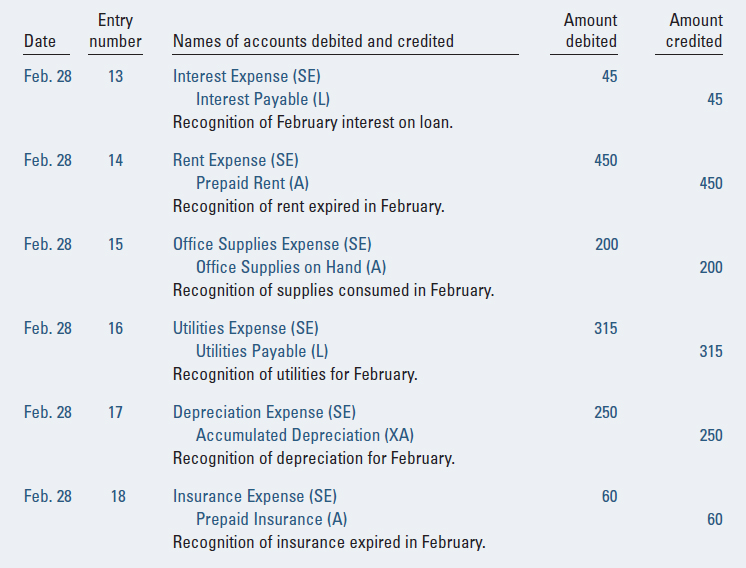
HELPFUL HINT
Notice that each of these adjusting entries involves both a balance sheet account and an income statement account. That is, one half of each adjusting entry (either the debit or the credit) is an asset or liability account, while the other half of the entry is a revenue or expense account.
EXHIBIT 3-12 DEMO COMPANY'S LEDGER AFTER THE ADJUSTING ENTRIES HAVE BEEN POSTED (except the adjustment for income tax)
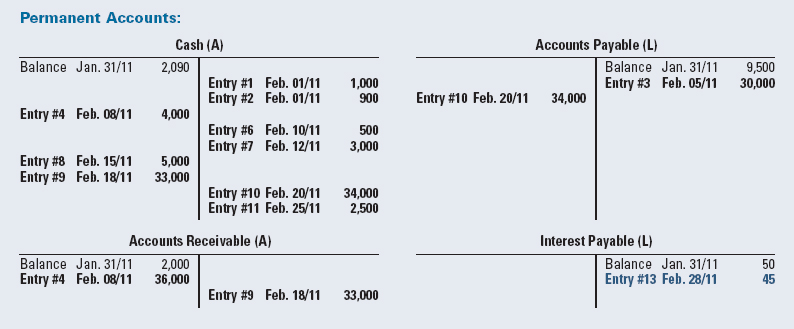
To determine the company's income before tax, we can now examine its ledger accounts and calculate the revenues minus the expenses. As you should recall, these are all listed in the temporary accounts section of the ledger in Exhibit 3-12. In Demo's case, the result is $40,000 − 27,000 − 2,800 − 450 − 315 − 200 − 250 − 60 − 45 = $8,880. (Remember that dividends are not an expense, and therefore are not involved in the calculation of income.) Applying Demo's tax rate of 25% to this yields the income tax expense for the period: 0.25 × $8,880 = $2,220.
ANALYSIS OF INCOME TAX ADJUSTMENT
Shareholders' Equity decreased by $2,220 (recorded as Income Tax Expense)
Liabilities (Income Tax Payable) decreased by $2,220
The rules of debit and credit specify that shareholders' equity is decreased by making debit entries, so the Income Tax Expense account must be debited. Since liabilities are increased by making credit entries, the Income Tax Payable account must be credited. Thus, this transaction is recorded in the journal as follows:
JOURNAL ENTRY FOR INCOME TAX ADJUSTMENT

Exhibit 3-13 presents Demo's ledger after the final adjusting entry, for income tax, has been posted. In addition, the balances in the accounts as of the end of February have been calculated and recorded.
EXHIBIT 3-13 DEMO COMPANY'S LEDGER AFTER ALL THE ADJUSTING ENTRIES HAVE BEEN POSTED AND THE ENDING BALANCES RECORDED
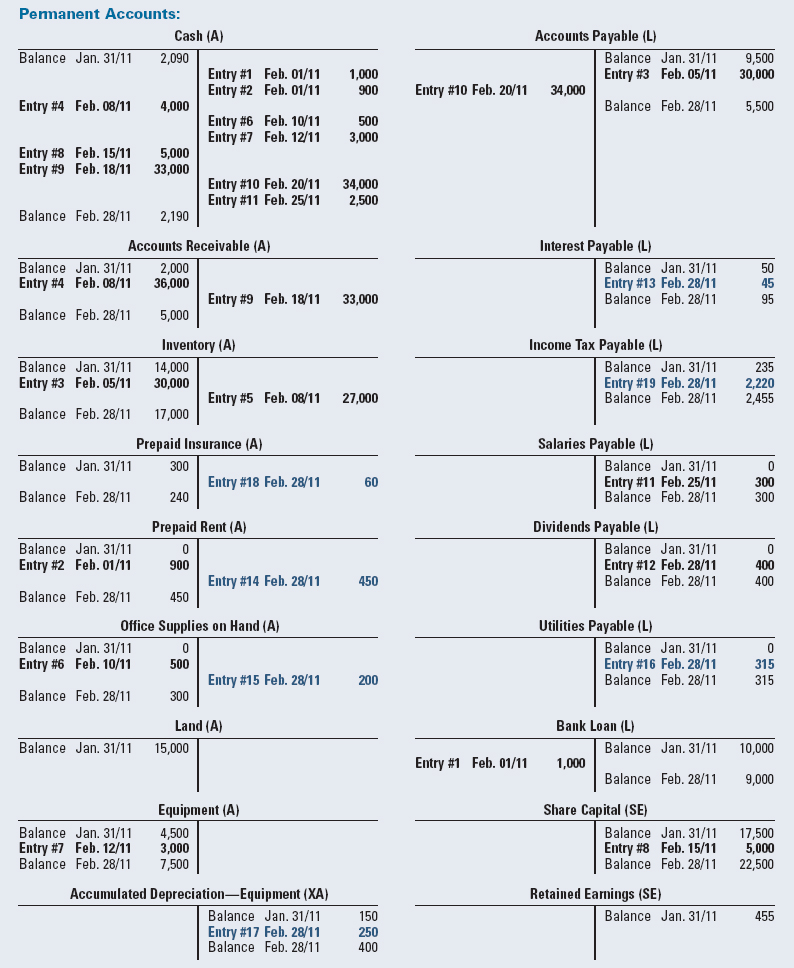
Preparing an Adjusted Trial Balance
After all the adjusting entries have been recorded and posted, an adjusted trial balance is prepared. This is done to ensure that the total debits in the accounts still equal the total credits; any imbalance must be corrected before the financial statements are prepared.
Exhibit 3-14 shows the adjusted trial balance for Demo Company as of the end of February. It is simply a listing of all the accounts and their balances; all the information has been taken directly from the ledger in Exhibit 3-13.
Note that, although the adjusted trial balance is dated February 28, 2011, the amount shown for retained earnings is the balance as of January 31 (the end of the preceding period). This is because all the changes affecting retained earnings in the current period are recorded in the temporary accounts (for revenues, expenses, and dividends declared). When the closing entries are made, the balances in the temporary accounts will be transferred into the retained earnings account and its balance will be brought up to date.
EXHIBIT 3-14 DEMO COMPANY'S ADJUSTED TRIAL BALANCE AS OF FEBRUARY 28, 2011

LEARNING OBJECTIVE 9
Prepare financial statements.
PREPARING FINANCIAL STATEMENTS AND CLOSING ENTRIES
Preparing the Financial Statements
After the adjusted trial balance has been prepared and any necessary corrections have been made, the financial statements for the period can be prepared. The statement of earnings is the first statement to be prepared, using the information for the revenue and expense accounts listed in the adjusted trial balance.
Exhibit 3-15 shows Demo Company's statement of earnings for the month of February, with comparative amounts for the preceding period.
EXHIBIT 3-15 DEMO COMPANY'S STATEMENT OF EARNINGS FOR THE MONTH OF FEBRUARY
(with comparative figures for the month of January)
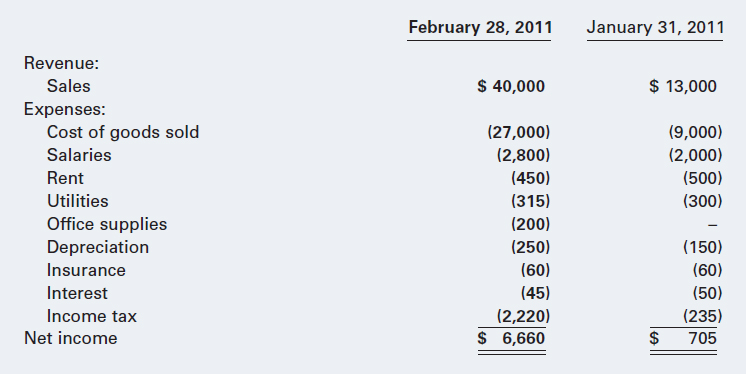
At this point, we are illustrating the simplest format for the statement of earnings. There many other ways to organize and present the information in a statement of earnings. These will be discussed in Chapter 4.
The revenue and expenses on the statement of earnings for February have been taken directly from the information presented for these accounts in the lower portion of Exhibit 3-14, the adjusted trial balance. Remember, however, that the last account listed in Exhibit 3-14, dividends declared, is not an expense account; consequently, it is not included on the statement of earnings. The amounts for January have simply been brought forward from the statement of earnings presented in Chapter 2 (page 104).
The statement of financial position is prepared next, but to do so we need to first determine the new balance in retained earnings, as of the end of February. As you may recall from Chapter 2, the following formula is used each accounting period to calculate the updated amount of retained earnings:
Retained Earnings at the end of the preceding period
+ Net Earnings (or − Net Loss) for the current period
− Dividends Declared in the current period
= Retained Earnings at the end of the current period
Applying this to Demo Company, its retained earnings on February 28 would be determined as follows:

The remaining statement of financial position data can be taken directly from the balances for the permanent accounts, shown in the upper portion of the adjusted trial balance (Exhibit 3-14).
Exhibit 3-16 shows Demo Company's statement of financial position as of the end of February, with comparative amounts for the preceding period.
As we discussed in Chapter 2, other formats can be used to present the statement of financial position. However, for examples in this book we will generally use a format similar to what is shown in Exhibit 3-16.
EXHIBIT 3-16 DEMO COMPANY'S STATEMENT OF FINANCIAL POSITION AT THE END OF FEBRUARY
(with comparative figures for the end of January)
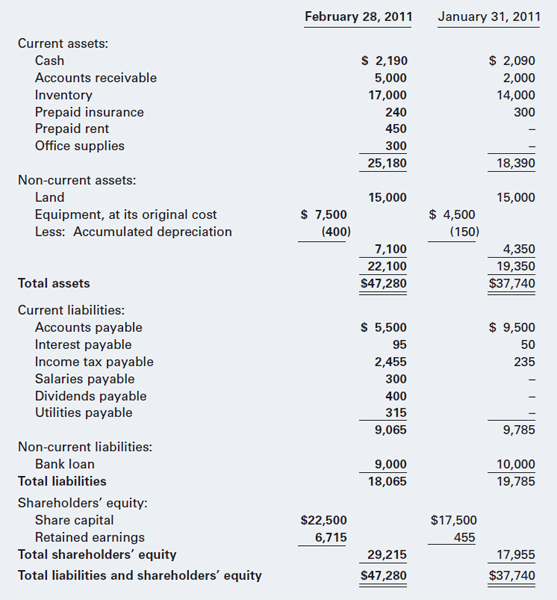
As you can see, Demo's statement of financial position at the end of February reflects the data listed in the adjusted trial balance for the permanent accounts, with the exception of retained earnings. That is, the amounts for the assets, liabilities, and share capital have been taken directly from Exhibit 3-14; only the amount for retained earnings had to be calculated (as we did, by adding the net income for February and deducting the dividends declared).
Notice how the contra-asset account Accumulated Depreciation is shown on the statement of financial position as a deduction from (or contra to) the associated asset account, Equipment. You should also notice how the balance in the accumulated depreciation account has grown from $150 at the end of January to $150 + $250 = $400 at the end of February. Over the life of the equipment, the balance in the accumulated depreciation account will continue to grow, by the amount of depreciation that is recorded each period. In other words, the depreciation expense amounts that are reported on the statement of earnings each period are added up (or accumulated) in the accumulated depreciation account that is reported on the statement of financial position. As each accounting period goes by, the accumulated depreciation balance will increase and the net remaining value of the asset will decrease, reflecting the fact that the equipment's value is used up as time passes.
The final major financial statement to be prepared is the statement of cash flows. However, since Chapter 5 is devoted entirely to this topic, we will defer any further discussion of the statement of cash flows until it is covered in detail in Chapter 5.
LEARNING OBJECTIVE 10
Explain closing entries and why they are necessary.
Preparing the Closing Entries
To complete the accounting cycle, the balances in the temporary accounts must be reset to zero, so that they will be ready to record data for the next accounting cycle. We do this by transferring the balances in the temporary accounts to retained earnings (which is a permanent account). The entries that accomplish this are called closing entries.
The first step in the closing process is to eliminate all the balances in the revenue and expense accounts, and transfer the net amount to the retained earnings account. To do this, we debit the revenues (to eliminate their credit balances), credit the expenses (to eliminate their debit balances), and credit retained earnings (to increase retained earnings by the difference between the revenues and the expenses, which equals the net earnings for the period).*
The second step in the closing process is to eliminate the balance in the dividends declared account and transfer it to the retained earnings account. To do this, we credit Dividends Declared (to eliminate its debit balance) and debit Retained Earnings (to reduce the retained earnings by the amount of dividends declared during the period).
Exhibit 3-17 shows the closing entries for Demo Company at the end of February.
EXHIBIT 3-17 DEMO COMPANY'S JOURNAL SHOWING ITS CLOSING ENTRIES FOR THE MONTH OF FEBRUARY
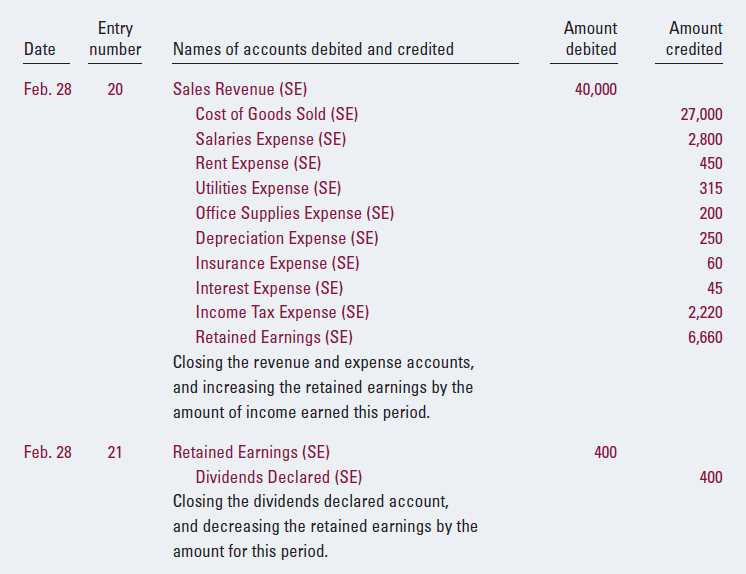
HELPFUL HINT
Points to remember about closing entries:
- The revenues are debited and the expenses credited, to eliminate their balances; the difference between these is the net earnings, which goes into retained earnings.
- The dividends declared account is credited, to eliminate its balance; since dividends reduce retained earnings, the retained earnings account is debited.
Exhibit 3-18 shows Demo's ledger after the above closing entries have been posted to the accounts. For easy reference, the postings for the closing entries are in red.
It is important for you to realize that the closing entries have achieved two key objectives:
- The balance in the retained earnings account has been brought up to date, by adding the income earned and deducting the dividends declared during the period that has just ended.
- The balances in all of the temporary accounts have been reset to zero, so that they are ready to start the next accounting period.
Rather than the simplified two-entry closing process that has been illustrated above, some companies use a four-entry closing process in which (1) the revenues are closed into another temporary account, called the Income Summary; (2) the expenses are also closed into the Income Summary account; (3) the Income Summary account is then closed into the Retained Earnings account; (4) the Dividends Declared account is closed into the Retained Earnings account. The combined effect of entries (1), (2), and (3) under this approach is equivalent to the first closing entry that we made for Demo Company, and entry (4) under this approach is identical to the second closing entry that we made for Demo. Either of these approaches is acceptable, as they both produce the same results.
HELPFUL HINT
Be sure to note that, although it is involved in the closing process, the retained earnings account is not closed. It is a permanent (statement of financial position) account, which is updated by the closing process.
In a computerized accounting system, the software package will perform the closing process automatically, when it is instructed to do so. Since the closing entries are the final step in the accounting cycle, you should make sure you have made all the appropriate adjustments, and prepared and reviewed the financial statements, before you instruct the program to close the books for the period.
EXHIBIT 3-18 DEMO COMPANY'S LEDGER AFTER THE CLOSING ENTRIES HAVE BEEN POSTED
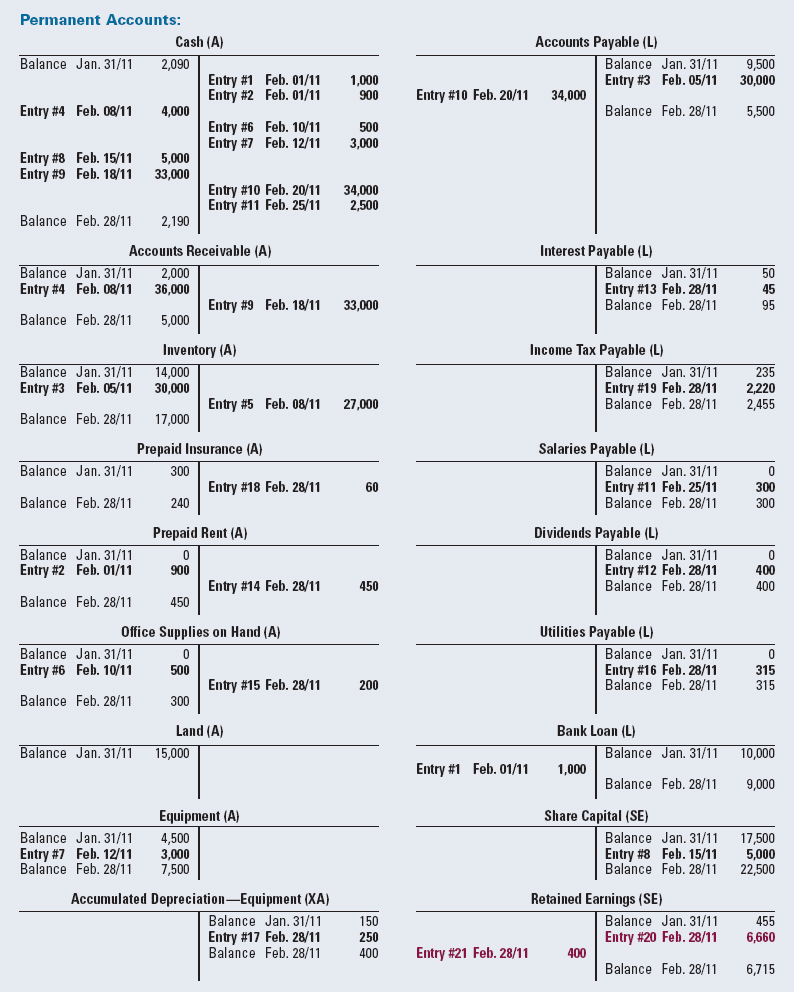
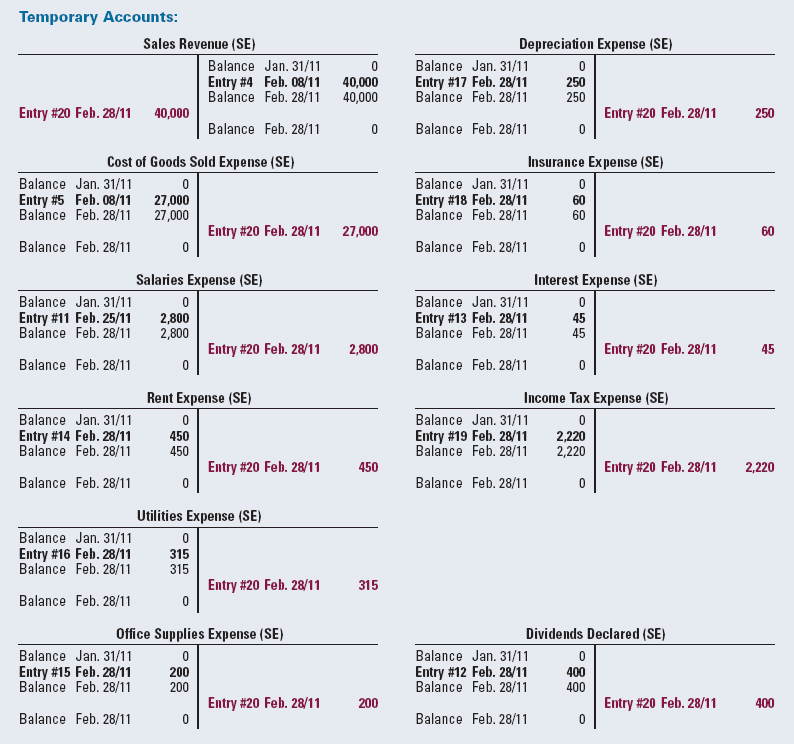
At this stage, some companies would prepare a post-closing trial balance. This would include only the permanent (statement of financial position) accounts, because all the temporary accounts now have zero balances. A post-closing trial balance serves as a final check on the accounting system, to ensure that it is in balance, before any transactions for the next period are recorded. This is an optional final step in the accounting cycle, and we are not illustrating it here.
Accounting Cycle Frequency
One final issue to look at is the question of how often the accounting cycle should be completed. In other words, how long should an accounting period be? Or, put differently, how often should financial statements be prepared? The answer is that financial statements should be prepared as often as necessary to provide timely information to management, shareholders, and other users. Since this preparation can be costly, especially in a manual accounting system, there is a trade-off between the benefits of having up-to-date information and the cost of preparing the financial statements. In some businesses it is essential to have up-to-date information on a regular basis, so daily or weekly financial statements may be needed. In other businesses, monthly statements are probably sufficient. For companies whose shares are traded on a public stock exchange, there is a requirement to file financial statements quarterly, as well as annually. Regardless of the time period, however, the accounting cycle steps and procedures described above are the same.
The frequency with which financial statements are prepared is sometimes expressed in terms of how often a company closes the books. If, as in our Demo example, the company closes its books every month, the company's accounting cycle is one month long. In such cases, adjusting entries are made on a monthly basis, so that the financial statements are as accurate as possible, and the temporary accounts are reset each month.
With a computerized accounting system, financial statements can very easily be generated weekly, monthly, quarterly, semi-annually, on a year-to-date basis, or for any specified time period. The accounting software can isolate all the transactions that were recorded for a particular period, and then prepare financial statements that include only the appropriate transactions. Because financial statements can be generated very quickly and easily in a computerized accounting system, it is feasible to produce them more frequently.
SUMMARY
This chapter built on the concepts introduced in Chapter 2 and explained the procedures underlying how financial information is collected, recorded, summarized, and reported in an actual accounting system. You should now understand debits and credits, journal entries, ledger accounts, trial balances, adjusting entries, and closing entries.
Whether in a manual accounting system or a computerized one, the underlying structures and processes are the same. In a computerized accounting system, the software takes care of the mechanical tasks, such as posting journal entries to the ledger accounts, preparing trial balances and financial statements, and closing the accounts. However, people with knowledge of accounting are still required to formulate transaction entries, make appropriate adjustments, and so on.
After the in-depth discussion of the accounting cycle presented in this chapter, you should be starting to feel more familiar and comfortable with accounting concepts, terms, and procedures. As you work through the problems at the end of this chapter, remember that the more effort you put in at this point, the easier the course will become later.
Additional Practice Problems
PRACTICE PROBLEM
Exhibit 3-19 presents the statement of financial position of Template Company as of December 31, 2010.
- Prepare a set of T accounts for Template Company, and enter the opening balances from the December 31, 2010, statement of financial position (in Exhibit 3-19).
- Using the transaction data that follows, prepare journal entries for the company's 2011 transactions and adjustments, and post the journal entries to the T accounts. Open new accounts as you need them.
- Prepare a statement of earnings for 2011, and a classified, comparative statement of financial position (showing amounts at the beginning and end of the year).
- Prepare the journal entries to close the accounts at the end of the year, and post the closing entries to the T accounts.
EXHIBIT 3-19 TEMPLATE COMPANY STATEMENT OF FINANCIAL POSITION, DECEMBER 31, 2010
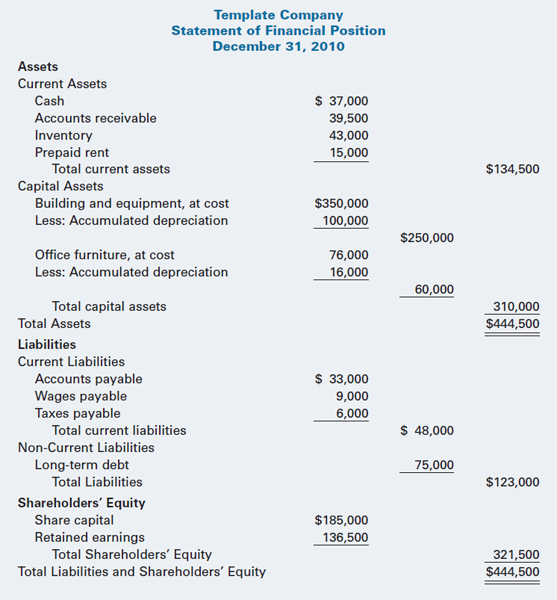
- Sales for the year totalled $760,000, all on account.
- A review of accounts receivable at the end of 2011 showed a balance of $35,000 remaining at that time.
- Purchases of new equipment totalled $40,700, all paid in cash.
- Depreciation for 2011 totalled $19,600. Eighty percent of this amount was related to the building and equipment, and the remainder to the office furniture.
- Rent was paid quarterly, in advance, on March 31, June 30, September 30, and December 31. Payments of $15,000 each were made on March 31 and June 30. Starting with the September 30 payment, the rent increased to $16,500 per quarter.
- The wages that were shown as payable as of December 31, 2010, were paid in 2011. In addition, the employees earned wages of $150,000 during the year. As of December 31, 2011, $11,000 of this amount had not yet been paid to the employees.
- Purchases of inventory, all on account, amounted to $431,000. (This is the only item that affects accounts payable.)
- On December 31, 2011, the company owed inventory suppliers a total of $36,000.
- The cost of the goods sold during the year was $417,000.
- The interest rate on the long-term debt is 8%, and the interest is paid on December 31 each year. On September 30, 2011, the company borrowed $15,000 in additional long-term debt, with the same interest terms.
- Other selling and administrative expenses of $45,000 were paid in cash.
- The company's net income is taxed at 30%. Some tax payments were made during the year, but $4,180 was still owed to the Canada Revenue Agency as of December 31, 2011.
- The company declared $5,000 in dividends in each quarter of 2011. These dividends were payable on April 15, 2011; July 15, 2011; October 15, 2011; and January 15, 2012.
STRATEGIES FOR SUCCESS:
- Rather than using pluses and minuses to show the effects of the transactions in a table (as we did in Chapter 2), you will now use debits and credits to record them as journal entries in T accounts. As you record the effects of the transactions, ensure that the total amount of debits equals the total amount of credits.
- Remember that debits are used to record increases in assets, while credits are used to record increases in liabilities and shareholders' equity accounts. Decreases are recorded in the opposite manner.
- Within the shareholders' equity group of accounts, bear in mind that investments made by the owners and revenues earned by the business both represent increases in shareholders' equity, and are therefore recorded as credits. On the other hand, dividends distributed to the owners and expenses incurred by the business both represent decreases in shareholders' equity, and are therefore recorded as debits.
- Bear in mind that expenses are costs that have been used up in the process of operating the business and generating revenues, while assets are costs that have not yet been consumed and will therefore be used to operate the business and generate revenues in the future.
- Analyze each transaction by thinking about what items are affected, and whether each of those items is increased or decreased. Then, based on the types of accounts involved and the rules of debit and credit (as summarized in Exhibits 3-2 and 3-3), determine what should be debited and what should be credited.
- When you encounter items that describe how much remains, remember that a remaining amount represents a balance in an account, rather than a transaction. Therefore, if you are told how much remains at the end of the period, you have to work backwards to determine what transaction must have occurred to create that ending amount. Then you can record the transaction in the manner described above.
SUGGESTED SOLUTION TO PRACTICE PROBLEM
The journal entries for Template Company are shown in Exhibit 3-20. Extended explanations for the more complex transactions are also provided.
EXHIBIT 3-20 TEMPLATE COMPANY'S JOURNAL ENTRIES FOR 2011

Transaction 2: Accounts Receivable
The information provided is the ending balance in the account. The cash collections are calculated based on the beginning and ending balances in Accounts Receivable combined with the amount of sales on account during the year, as follows:

Note that, after the journal entries for Transactions 1 and 2 are posted to the T accounts, the ending balance in the Accounts Receivable account will be the specified $35,000.
Transaction 4: Depreciation
The depreciation for the period is split between the building and equipment, and the office furniture. Both of these can use the same depreciation expense account (or they could be recorded in separate expense accounts); however, the accumulated depreciation must be recorded in separate contra-asset accounts, to be reported on the statement of financial position.
An accumulated depreciation account is referred to as a contra-asset, because it represents the portion of the asset that has been written off. Accordingly, it has a balance opposite to the related asset account (i.e., an asset has a debit balance, while a contra-asset has a credit balance). On the statement of financial position, the accumulated depreciation balance is deducted from the cost of the related asset.
Transaction 5: Rent
- The total cash payments during the period are (2 × $15,000) + (2 × $16,500) = $63,000. At the time these payments are made, they constitute an asset—prepaid rent.
- The beginning balance in the Prepaid Rent account on December 31, 2010, of $15,000 represents the payment made on December 31, 2010, covering the rent for the first quarter of 2011. The first two payments in 2011 (of $15,000 each, on March 31 and June 30) cover quarters two and three. The third payment of $16,500 on September 30 covers the fourth quarter. Therefore, the rent expense for 2011 should be the sum of these amounts, or [3 × $15,000] + $16,500 = $61,500. The last payment made (of $16,500 on December 31, 2011) applies to the first quarter of 2012 and therefore should be the ending balance in the Prepaid Rent account. After the two journal entries for Transaction 5 have been posted to the T accounts, the ending balance in the Prepaid Rent account will be the specified $16,500.
Also note that various other combinations of entries could be made to record these events. Any journal entries that result in the correct balances in the accounts are acceptable.
Transaction 6: Wages
We have assumed that the company first paid the wages owed from 2010 (in entry 6a). We have also assumed that the wages earned by the employees are first recorded as an expense and a liability (in entry 6b); then the liability is reduced when the wages are paid (in entry 6c). This is typically how companies account for wages. However, other combinations of entries could be made to record these events, and any journal entries that result in the correct balances in the accounts are acceptable.
Note that, as a result of these entries, there is a balance of $11,000 in wages payable at the end of the year, which is the amount that had not yet been paid to the employees.
Transaction 8: Accounts Payable
The beginning and ending balances in Accounts Payable, together with the amount of new purchases made on account during the year, are used to calculate the amount that was paid on account during 2011, as follows:

Note that, after the journal entries for Transaction 8 have been posted to the T accounts, the ending balance in Accounts Payable will be the specified $36,000.
Transaction 10: Interest
For the first nine months of the year, the interest is calculated on the initial balance of $75,000; for the last three months of the year, it is calculated on the new amount of debt, $90,000. The total interest for the year is therefore calculated as follows:

Transaction 12: Income Taxes
Taxes are calculated on the income before taxes. This can be calculated by going through the transactions and adjustments recorded in either the journal entries or the T accounts, and adding the revenues and subtracting the expenses. You should find that the income before taxes is $760,000 − 417,000 − 150,000 − 19,600 − 61,500 − 6,300 − 45,000 = $60,600. The tax expense is then calculated as 30% of this amount: 0.30 × $60,600 = $18,180.
The ending balance in the Taxes Payable account is then used to calculate how much Template Company must have paid in taxes in 2011, as follows:

Transaction 13: Dividends
The first three dividends declared in 2011 were paid in cash. Because the last dividend is still payable as at December 31, a new account, Dividends Payable, will appear on the statement of financial position.
The T accounts are shown in Exhibit 3-21. The opening balances (from December 31, 2010) have been shown in bold, and the posted transactions for 2011 are numbered. Exhibit 3-22 (page 207) shows the 2011 financial statements for Template Company. Exhibit 3-23 (page 208) presents Template Company's closing journal entries.
EXHIBIT 3-21 TEMPLATE COMPANY'S T ACCOUNTS FOR 2011
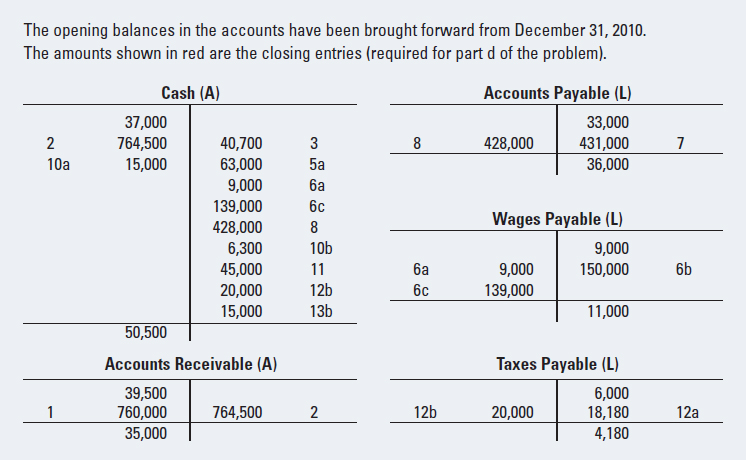
EXHIBIT 3-22 TEMPLATE COMPANY'S 2011 FINANCIAL STATEMENTS

EXHIBIT 3-23 TEMPLATE COMPANY'S CLOSING ENTRIES
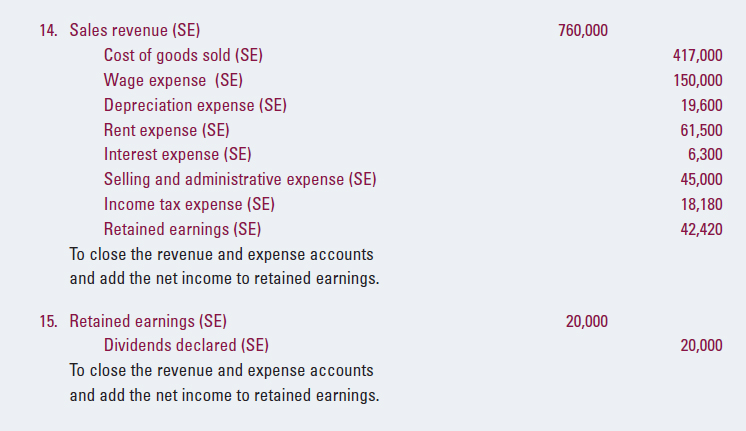
These entries have also been posted to the ledger (T accounts) in Exhibit 3-21. For easy reference, the closing entries are in red.
Note that, after posting the closing entries, all the revenue and expense accounts and the dividends declared account have zero balances. They are now ready to start the new accounting cycle for 2012. Also, the retained earnings account has been updated to reflect the cumulative amount as at the end of 2011.
ABBREVIATIONS USED
| A | Asset account |
| L | Liability account |
| SE | Shareholders' equity account |
SYNONYMS
Posting the accounts ![]() Posting to the ledger
Posting to the ledger

GLOSSARY
Accounting cycle The sequence of steps that occurs in the recording, summarizing, and reporting of events in the accounting system.
Accumulated depreciation The total amount of depreciation that has been taken on an asset, up to a particular point in time.
Adjusted trial balance A listing of the accounts and their balances after the adjusting entries have been made, but before the closing entries have been made.
Adjusting entries Journal entries made at the end of the accounting period to record an event or transaction that was not recorded during the period. Events or transactions that are not signalled in any other way are recorded through adjusting entries.
Chart of accounts A listing of the names of the accounts used in a particular accounting system.
Closing the books The process by which a company makes closing entries to complete one accounting period and set the balances in the temporary accounts to zero, in preparation for the next period. The temporary accounts are closed into the retained earnings account.
Closing entries Entries made at the end of the accounting period to transfer the balances from the temporary revenue, expense, and dividend accounts into the retained earnings account.
Compound entry A journal entry with more than two parts (i.e., multiple debits and/or multiple credits). Of course, as with any journal entry, the total amount debited must equal the total amount credited.
Contra-asset account An account used to record reductions in a related asset account. An example is accumulated depreciation.
Credit A reference to the right side of an account, or an entry made to the right side of an account.
Debit A reference to the left side of an account, or an entry made to the left side of an account.
Double-entry accounting system An accounting system that maintains the equality of the basic accounting equation by requiring that each entry have equal amounts of debits and credits.
Gross profit The difference between the revenue from the sales and the cost of the goods that were sold.
Income summary account An optional account that is often used when closing the books, to summarize all the temporary income statement accounts (revenues and expenses) before transferring the net income to retained earnings.
Journal The portion of the accounting system in which transactions and events are originally recorded, in chronological order.
Journal entry An entry made in a journal to record a transaction or event.
Ledger The portion of the accounting system in which transactions and events are summarized in accounts. Amounts are posted from the journal to the ledger.
Permanent accounts Accounts whose balances carry over from one period to the next. All statement of financial position accounts are permanent accounts.
Post-closing trial balance A trial balance prepared after the closing entries have been journalized and posted to the accounts. Since all the temporary accounts have zero balances at this point, it usually lists only the permanent accounts (i.e., statement of financial position accounts, whose balances are carried forward into the next period). This is an optional final step in the accounting cycle.
Posting the accounts The process of transferring the information recorded in journal entries to the ledger accounts. A synonym for posting to the ledger.
Posting to the ledger The process of transferring the information recorded in journal entries to the ledger accounts. A synonym for posting the accounts.
Rules of debit and credit For assets, increases are recorded with debits, and decreases with credits; for liabilities and shareholders' equity, increases are recorded with credits, and decreases with debits.
Synoptic journal A journal in which transactions are recorded in a spreadsheet format. Each account is assigned its own column, and amounts are added or subtracted inside the columns.
T account A simplified format for representing a ledger account, resembling the letter T.
Temporary accounts Accounts used to keep track of information temporarily during each accounting period. The balances in these accounts are eventually transferred to a permanent account (retained earnings) at the end of the period by making closing entries.
Trial balance A listing of all the ledger accounts and their balances. Used to check whether the total of the debit balances is equal to the total of the credit balances.

Self-Assessment Quiz
ASSIGNMENT MATERIAL
Assessing Your Recall
3-1 In general terms, explain the role of each of the two main financial statements for a business enterprise: the statement of earnings and the statement of financial position. Outline the type of information that each statement presents, and the basic difference between the types of items that appear on the statement of earnings versus those that appear on the statement of financial position.
3-2 Indicate whether each of the following statements is true or false:
- Under the accrual basis of accounting, when cash is collected on accounts receivable revenue is recorded.
- Cash receipts from customers are debited to accounts receivable.
- The cash basis of accounting recognizes expenses when they are incurred.
- Under the cash basis of accounting, there is no such thing as a prepaid rent account.
- Asset accounts and expense accounts have debit balances.
- Credits increase asset accounts.
- Revenues are recorded with credit entries.
- Dividends are an expense of doing business and should appear on the statement of earnings.
3-3 Indicate whether each of the following accounts normally has a debit balance or a credit balance:
- Sales Revenue
- Rent Expense
- Prepaid Rent
- Bank Loan
- Investment in Shares of X Company
- Accounts Receivable
- Accounts Payable
- Retained Earnings
- Dividends Declared
- Dividends Payable
- Depreciation Expense
3-4 Indicate whether each of the following accounts normally has a debit balance or a credit balance:
- Inventory
- Cost of Goods Sold
- Prepaid Insurance
- Wages Expense
- Wages Payable
- Interest Revenue
- Equipment
- Accumulated Depreciation—Equipment
- Long-Term Debt
- Share Capital
- Cash
3-5 The retained earnings account has a credit balance, and credit entries are used to record increases in this account. Explain why expense accounts (which are transferred to retained earnings when they are closed) have debit balances, and debit entries are used to record increases in these accounts.
3-6 List the steps in the accounting cycle, and briefly explain each step.
3-7 Why is it important for users of financial statements to have an understanding of how transactions are recorded, summarized, and reported?
3-8 In the adjusted trial balance part of the accounting cycle, the retained earnings account has its beginning-of-period balance, whereas the rest of the permanent accounts have their end-of-period balances. Explain why this is so.
3-9 Explain what is meant by the term “prepaid expense,” including how a prepaid expense arises and where it is reported in the financial statements.
3-10 Explain what is meant by the term “accrued expense,” including how an accrued expense arises and where it is reported in the financial statements.
3-11 Explain how a prepaid expense differs from an accrued expense.
3-12 If a company fails to record an accrued expense at the end of an accounting period, what effect will this omission have on the current period's financial statements, and on the next period's financial statements?
3-13 Explain the meaning of “depreciation expense” and “accumulated depreciation,” including how they differ and where each of these items appears in the financial statements.
3-14 Explain why closing entries are made, by stating the two objectives that are accomplished by making closing entries.
3-15 Discuss why one company might close its books monthly and another might close them weekly.
3-16 Describe the standard format of the statement of financial position.
3-17 Explain the meaning of the terms “current” and “non-current” as they apply to the statement of financial position.
3-18 Explain the meaning of the term “liquidity.”
Applying Your Knowledge
3-19 (Determine effects of transactions on statement of financial position accounts) Ann and Greg Fenway run a small art gallery and custom framing business. Explain how the basic statement of financial position accounts of assets, liabilities, and shareholders' equity would be affected by each of the following transactions and activities:
- Framing materials are purchased on credit.
- Payment is made for the framing materials that were purchased previously.
- Wages are paid to their assistant in the shop.
- Pictures are purchased by the gallery for cash.
- A picture is sold for cash, at a profit.
- A receivable is collected on a framing project that was completed for a customer last month.
- A loan from the bank is repaid, with interest.
- Depreciation on the equipment is recognized.
- Framing glue is spilled on some materials and they have to be discarded.
3-20 (Determine effects of transactions on statement of financial position accounts) Gagnon's Autobody Ltd. repairs and paints automobiles after accidents. Explain how the basic statement of financial position accounts of assets, liabilities, and shareholders' equity would be affected by each of the following transactions and activities:
- Gagnon's Autobody purchases new spray-painting equipment. The supplier gives the company 60 days to pay.
- The company pays for the spray-painting equipment that was purchased above.
- Supplies such as paint and putty are purchased for cash.
- The company pays for a one-year liability insurance policy.
- The company pays its employees for work done.
- A car is repaired and repainted. The customer pays the deductible required by her insurance policy, and the remainder of the bill is sent to her insurance company.
- Cash is collected from the customer's insurance company.
3-21 (Construct journal entries)
For each of the following transactions, construct journal entries:
- Inventory costing $3,100 is purchased on account.
- A payment of $3,000 was made on accounts payable.
- Inventory costing $1,800 is sold on account for $2,700. (Hint: Two journal entries are required.)
- Accounts receivable of $2,000 are collected.
- Office supplies costing $1,400 were purchased on account.
- Office supplies costing $500 were consumed during the period.
- New equipment costing $7,500 is purchased for cash.
- The company borrows $12,000 from a bank.
- The company issues common shares for $20,000.
- Wages totalling $6,300 were earned by employees and paid to them.
- The company paid $2,000 on its bank loan, which included $150 of interest.
- The company paid $2,500 for the monthly rent on its leased premises.
- Land costing $23,000 was purchased. The company paid $3,000 in cash and the remainder was financed with a mortgage (a long-term loan).
3-22 (Construct journal entries)
Chapati Company started business on January 1, 2011. Some of the events that occurred in its first year of operations follow:
- An insurance policy was purchased on February 28 for $1,800.
- During the year, inventory costing $140,000 was purchased, all on account.
- Sales to customers totalled $200,000. Of these, $40,000 were cash sales.
- Payments to suppliers (for inventory that had been purchased earlier) totalled $110,000.
- Collections from customers on account during the year totalled $140,000.
- Customers paid $25,000 in advance payments for goods that will be delivered later.
- Equipment worth $140,000 was purchased on October 1 for $40,000 cash and a two-year, 10% note with a principal amount of $100,000.
- Salaries totalling $44,000 were paid to employees during the year.
- The board declared dividends of $12,000 in December 2011, to be paid in January 2012.
- A year-end review revealed that the insurance policy (in item 1) was for one year of coverage that began on March 1, 2011.
- The equipment that was purchased on October 1, 2011, is to be amortized using the straight-line method, with an estimated useful life of 10 years and an estimated residual value of $20,000.
- No interest was paid on the note during the year.
- A physical count at year end revealed $20,000 of unsold inventory still on hand.
- It was determined that 80% of the goods that were paid for in advance (in item 6) had been delivered to the customers by the end of the year.
- In addition to the salaries that were paid during the year, salaries of $4,000 remained unpaid at the end of the year.
Required:
Prepare journal entries for each of the above transactions and adjustments.
3-23 (Journalize, post, and prepare trial balance)
Sweet Dreams Chocolatiers Ltd. began operations on January 1, 2011. During its first year, the following transactions occurred:
- Issued common shares for $200,000 cash.
- Purchased $475,000 of inventory on account.
- Sold inventory on account for $640,000. The original cost of the inventory that was sold was $380,000.
- Collected $580,000 from customers on account.
- Paid $430,000 to suppliers for the inventory previously purchased on account.
- Bought a delivery vehicle for $36,000 cash.
- Paid $26,000 for rent, including $2,000 related to the next year.
- Incurred $20,000 of other expenses, of which $18,000 was paid.
- Recorded $2,000 of depreciation on the vehicle.
- Declared and paid dividends of $6,000.
Required:
- Prepare journal entries to record each of the above transactions.
- Create T accounts and post the journal entries to the T accounts.
- Prepare a December 31, 2011, trial balance.
3-24 (Journalize, post, and prepare trial balance)
Sparkling Clean Dry Cleaners Inc. began operations on January 1, 2011. In its first year, the following transactions occurred:
- Issued common shares for $150,000 cash.
- Purchased dry cleaning equipment for $75,000 cash.
- Purchased cleaning supplies, on account, for $9,600.
- Used $8,400 of the supplies in cleaning operations.
- Collected $124,000 from customers for dry cleaning.
- Borrowed $15,000 from the bank on July 1, 2011, at an interest rate of 8% per year.
- Paid wages of $49,000 to employees. In addition to this, $1,000 of wages were owed to employees at the end of the year.
- Amortized the equipment by $3,000 for the year.
- Paid $22,000 for utilities (telephone, electricity, and water).
- Paid interest on the bank loan described in transaction 6.
Required:
- Prepare journal entries to record each of the above transactions.
- Create T accounts and post the journal entries to the T accounts.
- Prepare a December 31, 2011, trial balance.
3-25 (Journalize, post, and prepare trial balance and closing entries)
Refer to Problem 2-35 in Chapter 2 for Singh Company.
- Prepare journal entries for each of the transactions and adjustments listed in the problem.
- Prepare the necessary T accounts and post the journal entries to them.
- Prepare an adjusted trial balance.
- Prepare the closing entries and post them to the T accounts.
3-26 (Journalize, post, and prepare trial balance and closing entries)
Refer to Problem 2-36 in Chapter 2 for The Hughes Tools Company.
- Prepare journal entries for each of the transactions and adjustments listed in the problem.
- Prepare the necessary T accounts and post the journal entries to them.
- Prepare an adjusted trial balance.
- Prepare the closing entries and post them to the T accounts.
3-27 (Journalize, post, and prepare trial balance and closing entries)
Refer to Problem 2-37 in Chapter 2 for A.J. Smith Company.
- Prepare journal entries for each of the transactions and adjustments listed in the problem.
- Prepare the necessary T accounts and post the journal entries to them.
- Prepare an adjusted trial balance.
- Prepare the closing entries and post them to the T accounts.
3-28 (Determine statement of earnings amounts)
Jake Redding owns and operates a tire and auto repair shop named Jake's Jack'em and Fix'em Shop. During the current month, the following activities occurred:
- The shop charged $8,500 for repair work done during the month. All but one of his customers paid in full. The one customer who had not yet paid owed Jake $500. Jake still has the car in the shop's parking lot and he intends to keep it until the customer pays the bill. The $500 is included in the $8,500.
- The total cost of parts and oil purchased during the month was $2,900. Jake pays for the parts with cash, but the oil is purchased in bulk from a supplier on 30 days' credit. At the end of the month, he still owes $400 to this supplier.
- The cost of the parts that were used in repair work during the month was $2,600.
- Jake paid $750 monthly rent on the repair shop on the first day of the month, and since he had extra cash on hand at the end of the month he paid another $750 to cover the next month's rent.
- On the 10th of the month, Jake paid the previous month's utility bills of $250. At the end of the month, he received this month's utility bills, totalling $230, which he intends to pay on the 10th of next month.
- Jake paid a friend $500 for helping him in the repair shop, and also gave him a new set of tires from the shop's stockroom. These tires had cost Jake $300, and could have been sold to customers for $400.
- Other expenses related to operating the repair shop for the month totalled $875. All of these were paid during the month, as well as $125 that was owed from the previous month.
- During the last week of the month, a customer dropped off her vehicle for repair work. Jake set aside $600 of parts to be used in these repairs, but he has not yet had time to do any work on this job.
With reference to the concepts discussed so far in the book, determine the amounts that would properly be reported in the statement of earnings for Jake's shop this month, and calculate the net earnings for the month. If an item is excluded, explain why.
3-29 (Determine statement of earnings amounts)
Jan Wei owns a cycle store that sells equipment, clothing, and other accessories. During the month of June, the following activities occurred:
- The business earned $30,000 from the sale of bicycles, clothing, and accessories. Half the sales were for cash and the other half was paid for with credit cards. The money for the credit card sales, less a 3% charge, was collected from the credit card company.
- The merchandise that was sold originally cost $17,400.
- Jan purchased additional merchandise on credit for $20,800.
- Jan paid $18,000 to the suppliers of the merchandise purchased above.
- The telephone, electricity, and water bills for the month came to $430. All but one of these bills, for $130, was paid by the end of the month.
- Other expenses for the month totalled $2,100. They were all paid in cash, except the depreciation expense, which was $600.
- At the end of May, Jan had an 8% loan for $5,000 outstanding with the bank. On the last day of June, Jan paid the monthly interest that was owed on the loan, and also paid $500 on the loan principal.
- On the last day of June, a customer ordered a $1,300 bicycle. Jan did not have it in stock, so it was ordered and will be delivered in July. Since it was a special order, the customer paid a $300 deposit on it.
Required:
With reference to the concepts discussed so far in the book, determine the amounts that would properly be reported in the June statement of earnings for Jan's shop, and calculate the net earnings for the month. If an item is excluded, explain why.
3-30 (Determine expenses using matching principle)
For each of the following independent cases, apply the matching concept to determine how much of the cost should be recognized as expense in each of the months of September, October, and November:
- A new lease for the business premises goes into effect on October 1 and increases the rent from $1,000 to $1,150 per month. The rent for the next month is always prepaid on the last day of the current month. Accordingly, rent of $1,000 was paid on September 30, and $1,150 was paid on October 31 and November 30.
- The company borrowed $12,000 on September 1. The loan is to be repaid on December 1, along with $300 of interest.
- The company purchased a large supply of lubricant for $2,000 on September 1. The lubricant is to be used in the company's operations and is expected to last for four months.
- Employees work Monday through Friday and are paid each Monday for the previous week's work. The payroll for the week of Monday, September 29 to Friday, October 3 (paid on October 6) is $10,000. The payroll for the week of Monday, October 27 to Friday, October 31 (paid on November 3) is $10,500.
3-31 (Determine previous account balances)
Selected items from the adjusted trial balance for Puzzle-Solver Consulting Services as of January 31, 2012, follow:
Partial Adjusted Trial Balance as of January 31, 2012

Required:
- If supplies costing $1,000 were purchased in January, determine what the balance in the Supplies on Hand account must have been at the beginning of the month.
- If the insurance amounts relate to a policy with an original term of one year, determine the total premium that was paid and the date on which the policy was purchased.
- If the amount paid for salaries during the month was $3,000, determine what the balance in the Salaries Payable account must have been at the beginning of the month.
- If there are no accounts receivable, and the amount of fee payments received during the month was $3,000, determine what the balance in the Unearned Fees account must have been at the beginning of the month.
3-32 (Journalize, post, prepare statement of earnings and statement of financial position, and prepare closing entries)
On December 31, 2010, Clean and White Linen Supplies Ltd. had the following account balances:
| Cash | $90,000 |
| Accounts receivable | 96,000 |
| Uniforms for sale | 60,000 |
| Supplies on hand | 2,000 |
| Investment in Golden Company | 80,000 |
| Equipment | 330,000 |
| Accumulated depreciation | 90,000 |
| Accounts payable | 60,000 |
| Wages payable | 8,000 |
| Long-term bank loan, 7% | 150,000 |
| Share capital | 250,000 |
| Retained earnings | 100,000 |
In 2011, the following transactions occurred:
- On January 1, paid $3,900 for a three-year fire insurance policy.
- Purchased additional uniforms on credit for $120,000.
- Sold uniforms for $180,000 on account. The inventory that was sold had been purchased for $100,000.
- Performed cleaning services for customers for $520,000. One-quarter of this amount was paid in cash and the remainder was on account.
- Paid $130,000 to suppliers to settle some of the accounts payable.
- Received $246,000 from customers in settlement of amounts owed to the company.
- Paid $12,000 for advertising.
- At the end of 2011, paid the interest on the bank loan for the year, as well as $30,000 on the principal.
- Received a $3,000 dividend from the investment in Golden Company.
- Paid $15,000 for utilities for the year.
- Paid dividends of $12,000 at the end of the year.
- Paid $102,000 for wages during the year. At year end, the company still owed $2,000 to the employees for the last week of work in December.
- Amortized the equipment for the year. The company had bought its equipment at the beginning of 2008, and it was expected to last 10 years and have a residual value of $30,000.
- Made an adjustment for the cost of the insurance that expired in 2011.
Required:
- Prepare journal entries to record each of the above transactions and adjustments.
- Create T accounts. Enter the beginning balances from 2010, post the 2011 journal entries, and determine the ending balances for 2011.
- Prepare an adjusted trial balance, and ensure that the total of the debit balances is equal to the total of the credit balances. (If your totals are not equal, you should use the procedures outlined in the Helpful Hint on page 179 to try to locate the error.)
- Prepare a statement of earnings and a statement of financial position for 2011.
- Prepare the closing entries and post them to the T accounts.
3-33 (Prepare journal entries, trial balances, and closing entries)
Evergreen Retail Company, whose fiscal year end is December 31, had the following transactions in its first year of operations:
- Issued common shares for $65,000 cash on January 1, 2011.
- Borrowed $15,000 of additional financing from the bank on January 1, 2011.
- Bought equipment for $25,000 cash, also on January 1, 2011.
- Made $60,000 of inventory purchases on account.
- Had total sales of $92,000, of which $28,000 were on account. The cost of the products sold was $44,000.
- Bought office supplies for $800 cash.
- Collected payments of $24,000 from customers on their accounts.
- Paid suppliers $25,000 for the inventory that had been purchased on account.
- Paid employees $36,200.
- Paid the interest on the bank loan on December 31, 2011. The interest rate was 8%.
- Declared dividends of $2,000, which will be paid in 2012.
- The equipment purchased on January 1 has an estimated useful life of eight years and an estimated residual value of $1,000 at the end of its life.
- Office supplies costing $200 were still on hand at the end of the year.
- Wages in the amount of $800 were owed to employees at the end of the year. These will be paid early in 2012.
Required:
- Prepare journal entries for transactions 1 through 11.
- Set up T accounts, post the 2011 transactions, and calculate the unadjusted balance in each account.
- Prepare a trial balance, and ensure that the total of the debit balances is equal to the total of the credit balances. (If your totals are not equal, you should use the procedures outlined in the Helpful Hint on page 179 to try to locate the error.)
- Prepare journal entries for adjustments 12 to 14.
- Post the adjusting entries, and recalculate the balances in the accounts involved.
- Prepare the closing entries, post them to the T accounts, and calculate the final balance in each account.
3-34 (Journalize, post, prepare statement of earnings and statement of financial position, and prepare closing entries)
Perfect Pizza had the following account balances at December 31, 2010:
| Cash | $ 33,000 |
| Accounts receivable | 15,000 |
| Ingredients and supplies inventory | 10,000 |
| Prepaid rent | 3,000 |
| Equipment | 60,000 |
| Accumulated depreciation—equipment | 30,000 |
| Delivery vehicles | 80,000 |
| Accumulated depreciation—delivery vehicles | 36,000 |
| Accounts payable | 7,000 |
| Wages payable | 2,000 |
| Share capital | 110,000 |
| Retained earnings | 16,000 |
During 2011, the following transactions occurred:
- Purchases of ingredients and supplies (ingredients and supplies inventory) were $230,000, all on account.
- Sales of pizzas for cash were $510,000, and sales of pizzas on account were $40,000.
- The company paid $88,000 for wages and $42,000 for other expenses.
- Payments for ingredients and supplies purchased on account totalled $220,000.
- Collections from customers for sales on account totalled $50,000.
- Ingredients and supplies valued at $225,000 were used in making pizzas.
- A dividend of $15,000 was declared and paid at the end of the year.
Information for adjusting entries:
- At the end of 2011, the amount of rent paid in advance was $1,500.
- Wages owed to employees at the end of 2011 were $2,500.
- The equipment had an estimated useful life of eight years, with no residual value.
- The delivery vehicles had an estimated useful life of six years with a residual value of $8,000.
Required:
- Prepare journal entries for transactions 1 through 7. Create new accounts as necessary.
- Set up T accounts. Enter the beginning balances from 2010, post the 2011 journal entries, and determine the unadjusted balance in each account.
- Prepare a trial balance.
- Prepare journal entries for adjustments 8 through 11. Post these journal entries to the T accounts, and determine the adjusted balance in each account.
- Prepare an adjusted trial balance.
- Prepare a statement of earnings and statement of financial position for 2011.
- Prepare the closing entries, post them to the T accounts, and determine the final balance in each account.
3-35 (Prepare journal entries, trial balances, and closing entries)
Genesis Sportswear Ltd. is a wholesale company that buys sports clothing from manufacturers and sells it to retail stores. It had the following transactions in its first year of operations. The company's fiscal year end is December 31.
- Common shares were issued for $60,000.
- An insurance premium that provides coverage for the 12-month period starting March 1 was bought for $1,200 on February 15.
- Clothing was purchased for $75,000 on account.
- Employees were paid $46,900 in wages.
- Other operating expenses totalled $10,000. Of this amount, $9,000 was paid during the year; the remainder was due to be paid early in the next year.
- Sales recorded for the period totalled $105,000, all on credit.
- The cost of the inventory sold during the year was $62,000.
- Cash collections on customer accounts totalled $96,000.
- Payments to suppliers for clothing purchased totalled $54,000.
- New equipment was purchased for $15,000 cash.
- Dividends of $6,000 were declared but not yet paid.
Adjusting entries (Hint: You may need to use information recorded in the first 11 transactions.):
- Recognized the amount of insurance expense that was incurred during the period.
- Recorded depreciation of $2,000 on the equipment.
Required:
- Prepare journal entries to record transactions 1 through 11.
- Create T accounts, post the journal entries to them, and determine the unadjusted balance in each account.
- Prepare a trial balance.
- Prepare journal entries for items 12 and 13, post these adjustments, and calculate the adjusted balances in the affected accounts.
- Prepare the closing entries, post them to the T accounts, and determine the final balance in each account.
3-36 (Determine amounts to appear in financial statements)
The following is the final trial balance (after the adjusting and closing entries had been made) for Hartman Company as at August 31, 2011. Hartman adjusts and closes its books at the end of each month.
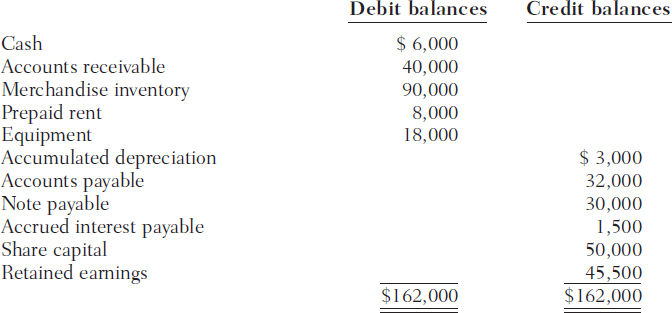
Hartman's transactions in September 2011 and all relevant data for month-end adjustments follow:
- Sales on account were $41,000.
- Payments of $37,000 were collected from customers on their accounts.
- Cash sales were $50,000.
- Merchandise was purchased for $39,000 on account.
- The cost of merchandise sold in September was $59,000.
- Payments of $33,000 were made to suppliers for accounts owing.
- Advertising costs of $3,000 were paid.
- Employees were paid $15,000 in wages.
- Wages of $1,000 were earned by employees but not yet paid.
- Miscellaneous expenses of $9,000 were paid in cash.
- The rent was paid in advance to December 31, 2011. The payment was made earlier in the year.
- The equipment was purchased on September 1, 2010 (one year before the start of the current month), and is expected to have a total useful life of six years.
- The note payable was dated March 1, 2011, and the principal is due to be repaid in two equal instalments on March 1, 2012 and 2013. Interest on the note, at a rate of 10% per year, is also to be paid on March 1, 2012 and 2013.
Required:
Based on the above information, answer the following questions:
- What amount should Hartman report as revenue for September?
- What amount should Hartman report as wages expense for September?
- What amount should Hartman report as rent expense for September?
- What amount should Hartman report as interest expense for September?
- As of the end of September, what should the balance in Hartman's cash account be?
- As of the end of September, what is the amount of Hartman's accounts receivable?
- As of the end of September, what should the balance in Hartman's merchandise inventory account be?
- As of the end of September, what is the amount of Hartman's accounts payable?
- Is the equipment expected to have any value at the end of its useful life?
- As of September 30, 2011, what is the net book value of Hartman's equipment?
- What amount should be shown under Long-Term Liabilities, on Hartman's statement of financial position as of September 30, 2011?
3-37 (Prepare adjusting entries)
The trial balance for Cozy Fireplaces Inc. for December 31, 2011, follows:
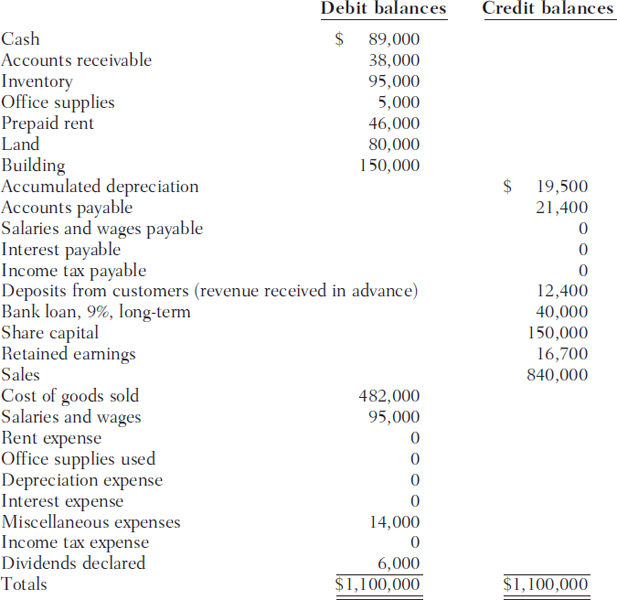
Additional information for adjusting entries:
- The deposits from customers were for future deliveries. As of December 31, three-quarters of these goods had been delivered.
- There is $2,000 in salaries and wages owed at year end.
- Rent is paid in advance on the last day of each month. There was a balance of $3,000 in the prepaid rent account on January 1, 2011. At the end of January, $3,000 was paid for the February rent and was debited to the prepaid rent account. All the rent payments during the year were treated the same way. The rent for July to December increased to $4,000 per month. (Hint: Determine the amount of rent expense for 2011, as well as the correct amount that has been prepaid for 2012, and make an adjustment that will bring both these accounts to the correct balances.)
- A count of the office supplies at year end revealed that $500 of supplies were still on hand.
- The building is being depreciated over 20 years with a residual value of $20,000.
- The bank loan was taken out on April 1, 2011. The first interest payment is due on April 1, 2012.
- Income tax for the year should be calculated using a tax rate of 30%. (Hint: After you finish the other adjusting entries, you will have to determine the income before income tax and then calculate the tax as 30% of this amount.)
Required:
Prepare the adjusting entries for the year 2011.
3-38 (Prepare adjusting entries)
The following trial balance before adjustments is for Snowcrest Ltd on December 31, 2011:
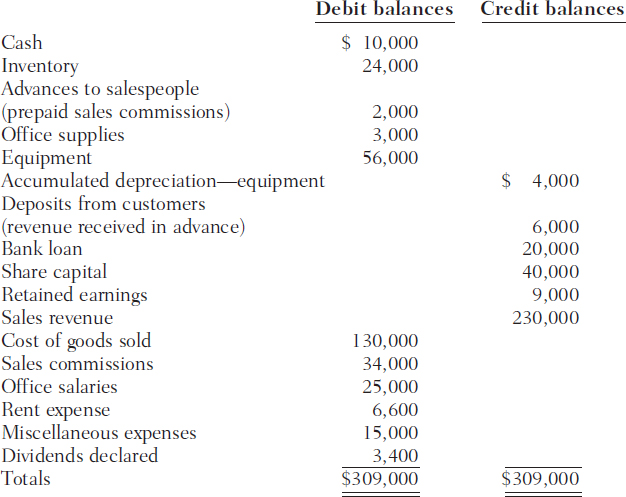
Data for adjusting entries:
- As of December 31, 2011, 80% of the commissions that had been paid in advance to the salespeople had been earned.
- A count of the office supplies at the end of the year revealed that $600 of supplies were still on hand.
- Depreciation on the equipment for 2011 was $1,000.
- The deposits from customers were advance payments for future deliveries of goods. By December 31, 2011, two-thirds of these deliveries had been made.
- The bank loan was a six-month loan taken out on October 1, 2011. The interest rate on the loan is 9%, but the interest is not due to be paid until the note is repaid on March 1, 2012.
- Office salaries owed at year end and not yet recorded were $500.
- The rent expense figure includes $600 paid in advance for January 2012.
- Income tax for the year should be calculated using a tax rate of 25%. (Hint: After you finish the other adjusting entries, determine the income before income tax and then calculate the tax as 25% of this amount.)
Required:
Prepare the adjusting entries for the year 2011.
3-39 (Determine statement of earnings and statement of financial position values)
The following information was available for Brilliant Consulting Company at its year end, December 31, 2011:
- During the year, the company agreed to provide certain consulting services to a client for a fee of $10,000, which was received in advance. At the end of the year, it was estimated that 85% of the services had been provided.
- The Office Supplies account had a balance of $350 at the beginning of the year and additional supplies costing $950 were purchased during the year. At the end of the year, a count of the office supplies indicated that supplies costing $250 remained on hand.
- A new “business occupancy” tax was introduced by the municipal government in 2011, and the company was required to pay $1,800 to cover the period from April 1, 2011, to March 31, 2012.
- The company rents some surplus space in its building to a tenant for $1,500 per quarter, payable in advance. The agreement began on September 1, 2011, and the tenant paid $1,500 on that date and an additional $1,500 on December 1.
- Another tenant rents space in the company's building for $750 per month, due on the first day of each month. The agreement began several years ago and the tenant has paid the rent as scheduled every month, except for the most recent one. At year end, the rent for December 2011 was still outstanding.
- During the year, the company engaged an advertising agency and paid $3,000 for its services. In addition to this, there were unpaid advertising bills at year end totalling $450; these are due in January 2012.
Required:
For each of the items above, indicate what should appear on the statement of earnings for the year ended December 31, 2011, and on the statement of financial position as of that date.
3-40 (Determine statement of earnings and statement of financial position values)
The Great Graphics Group began operations on January 1, 2010. At the end of its second year of operations, and before any adjustments had been made, the trial balance was as follows:

Analysis reveals the following additional data for adjustments to be made:
- There were $2,000 of supplies on hand at year end.
- The note payable was issued on October 1, 2011. It is a nine-month note, with an interest rate of 9% per year. The interest does not have to be paid until July 1, 2012, when the note is due to be repaid.
- The balance in the Prepaid Insurance account is the premium paid for a one-year policy that began March 1, 2011.
- By year end, $4,500 of the amount recorded in the Unearned Consulting Fees account had been earned.
- At year end, $3,000 of additional graphic design fees had been earned, but not yet billed or recorded. The work was completed in December 2011, and the clients will pay for it in January 2012.
- The equipment was acquired on April 1, 2010, and is being amortized at a rate of $4,400 per year.
Required:
Calculate the amount that should appear (after adjustments) on the December 31, 2011, financial statements for each of the following items:
- On the statement of earnings, related to supplies
- On the statement of financial position, related to interest
- On the statement of financial position, related to insurance
- On the statement of earnings, related to consulting fees
- On the statement of earnings, related to graphic design fees
- On the statement of financial position, as the net book value of the equipment
3-41 (Determine effects of omitted adjustment)
When it was preparing its financial statements for the year ended December 31, 2011, a company failed to record $3,000 of accrued salaries. These salaries were paid, and recorded as an expense, in 2012.
Required:
State the effect (if any) that this error will have on each of the following financial statement items:
- Net earnings for 2011
- Total assets on December 31, 2011
- Total liabilities on December 31, 2011
- Total shareholders' equity on December 31, 2012
- Net earnings for 2012
- Total assets on December 31, 2012
- Total liabilities on December 31, 2012
3-42 (Determine adjusted balances; prepare statement of earnings and statement of financial position)
On December 31, 2011, Information Inc. completed its third year of operations. The following list of account balances (which are not arranged in any particular order) was assembled by a student working in the company's business office on a part-time basis while taking his first accounting course:

The foregoing items are correct, but the following information was not taken into consideration:
- The amount shown as insurance expense includes $900 for coverage during the first two months of 2012.
- The note receivable is a six-month note that has been outstanding for four months. The interest rate is 10% per year. The interest will be received by the company when the note becomes due at the end of February 2012.
- As of December 31, 2011, the office supplies still on hand are worth $600.
- On November 1, 2011, the company rented surplus space in its building to a tenant for $1,000 per month, payable in advance for six months.
- Depreciation for 2011 is $10,000 on the building and $20,000 on the equipment.
- Employees earned $3,000 of salaries in December 2011 that will not be paid until the first scheduled pay day in 2012.
- Additional dividends of $50,000 were declared in December 2011, but will not be paid until January 2012.
Required:
- Determine the amounts that would appear in an adjusted trial balance for Information Inc. as of December 31, 2011.
- Prepare a statement of earnings for the year ended December 31, 2011.
- Calculate the amount of retained earnings as of December 31, 2011.
- Prepare a classified statement of financial position as of December 31, 2011.
3-43 (Calculate income and retained earnings; prepare statement of financial position)
Little Lads and Ladies Ltd. sells children's clothing. At the end of December 2011, it had the following adjusted account balances, which are listed in random order:
Required:
- Identify the statement of earnings accounts and calculate the net earnings (or loss) for the year.
- Determine the amount of retained earnings at the end of 2011.
- Prepare a classified statement of financial position as of December 31, 2011.
3-44 (Calculate income and retained earnings; prepare statement of financial position)
Your assistant prepared the following adjusted trial balance data for Commerce Company on December 31, 2011. The accounts are arranged in alphabetical order.
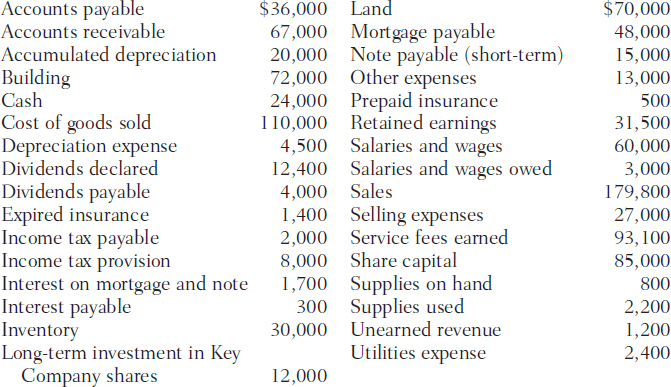
Required:
- Calculate the net income for the year ended December 31, 2011.
- Determine the retained earnings balance as at the end of the year.
- Prepare a classified statement of financial position as of December 31, 2011.
3-45 (Prepare statement of financial position—manufacturing company)
The following adjusted trial balance data are for Novasco Manufacturing Corporation as at December 31, 2011. (Note: The accounts are listed in alphabetical order, first for debit balances, then for credit balances.)
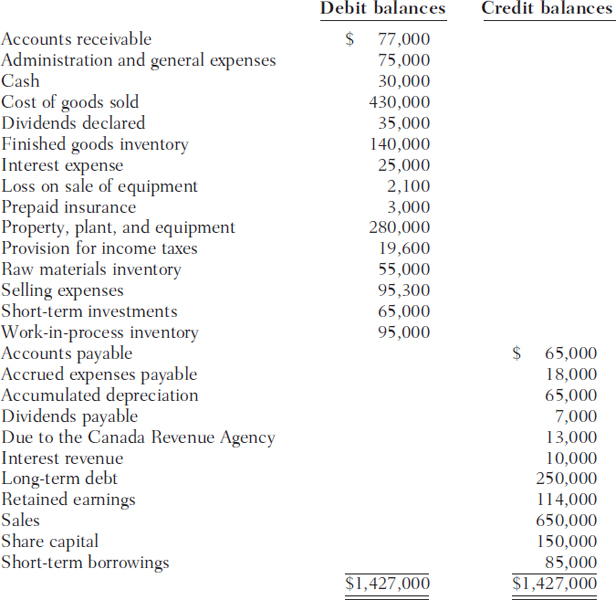
Required:
Prepare a classified statement of financial position for Novasco Manufacturing Corporation as at December 31, 2011.
3-46 (Determine missing amounts in financial statements)
Lee's Enterprises Ltd. suffered serious flood damage that destroyed most of its accounting records. The following statements were reconstructed from the records that were recovered, but many of the amounts are missing:
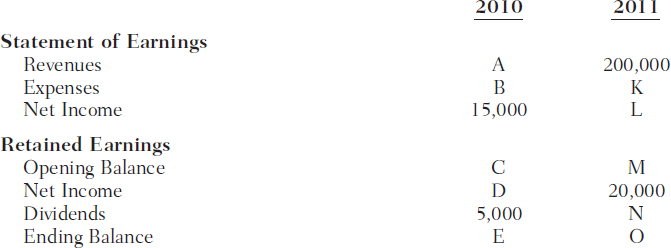
The following information is also available, to help you determine the missing amounts:
- The company's retained earnings balance at the end of 2009 was $10,000.
- The company's profit margin ratio was 15% in 2010 and 10% in 2011.
- In both 2010 and 2011, the company's current assets were twice the amount of the current liabilities.
Required:
For each of the letters above, determine the missing dollar amount that will complete the financial statements. (Hint: It might not be possible to find all the missing amounts in the order they are presented in. You may have to skip over some, initially, and come back to them after you have determined other items.)
3-47 (Determine missing amounts in financial statements)
Rao's Recycling Centre suffered a serious fire that destroyed most of the firm's accounting records. The following statements were reconstructed from the records that were recovered, but many of the amounts are missing:
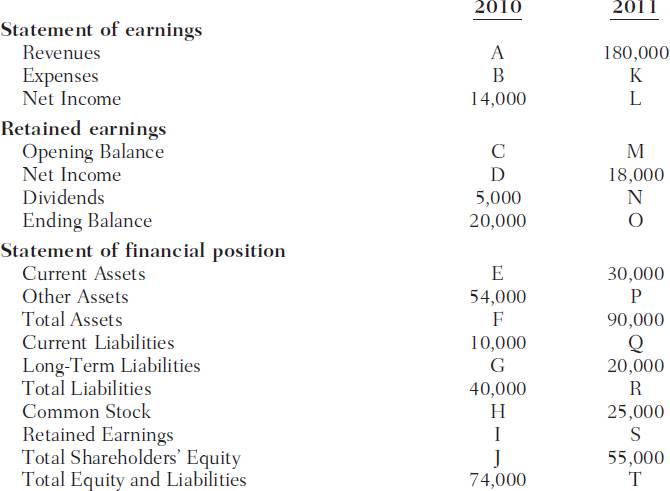
The following information is also available, to help you determine the missing amounts:
- The company's profit margin ratio was 10% in both 2010 and 2011.
- In both 2010 and 2011, the company's current assets were twice the amount of the current liabilities.
For each of the letters above, determine the missing dollar amount that will complete the financial statements. (Hint: It might not be possible to find all the missing amounts in the order they are presented in.)
User Perspective Problems
3-48 (Establish chart of accounts)
Saskco Chicken Products is a new company established by four entrepreneurs from Moose Jaw, Saskatchewan. They intend to purchase live chickens, process them, and sell them as frozen pieces. They anticipate hiring 17 workers to process the chickens. The four owners will work in the business and have the following titles: President (overseeing the whole operation, including finance and accounting), VP Procurement (in charge of purchasing chickens from farmers), VP Operations (in charge of the processing operations), and VP Marketing.
The president has hired you to help the company set up a computerized accounting system. First she wants you to create a list of account titles that you think the company will need for its operations. Second, for each account title, she wants you to provide a brief explanation of its nature and your reason for including it in the chart of accounts.
3-49 (Discuss end-of-period accounting process)
Accounting system procedures require some time at the end of each accounting period to check for errors, make adjusting entries, prepare the financial statements, etc. In recent years, most companies have been under pressure to speed up this end-of-period process. Discuss the incentives that companies might have to make this a faster process.
3-50 (Discuss necessity of month-end adjustments)
In order to monitor and control its operations, your company prepares monthly financial statements. An executive meeting is held in the latter part of each month to review the previous month's statements and discuss the company's progress.
A new member of the executive team asks why these meetings are not held at the beginning of each month. The chief financial officer (CFO) replies that, because of the adjustments that have to be made, the financial statements are not ready until near the middle of the month. This prompts someone to ask, “Is it really necessary to make adjustments every month? Couldn't the process be simplified and sped up by only making adjustments for the year-end statements? After all, the monthly financial statements are only used internally, for management control purposes; only the year-end statements are used externally and therefore have to conform with financial reporting standards.”
The CFO asks you to prepare a response to these questions with a brief discussion of the shortcomings of unadjusted financial statements, including the reliability of the results and the possibility of manipulation.
3-51 (Assess performance and set goals)
Northland Enterprises sells and services snowmobiles and other recreational vehicles, and has reported the following revenues and expenses for the year ended December 31, 2011:
| Sales of recreational vehicles | $6,000,000 |
| Sales of replacement parts | 800,000 |
| Revenue from repair work (parts and labour) | 1,100,000 |
| Interest earned on investments | 40,000 |
| Cost of recreational vehicles sold | 3,400,000 |
| Cost of replacement parts sold | 490,000 |
| Cost of labour and parts used for repair work | 400,000 |
| Shipping and delivery costs | 280,000 |
| Selling and administrative salaries | 450,000 |
| Other operating expenses | 500,000 |
| Interest expense on mortgage | 70,000 |
| Loss on sale of old equipment | 10,000 |
| Income tax expense | 740,000 |
- Prepare a 2011 statement of earnings for Northland Enterprises in a format that you think will be useful for management analysis.
- Which aspect of the company's operations (sales of recreational vehicles, sales of replacement parts, or repair work) seems to be the most profitable?
- In 2010, Northland had total revenues of $7,200,000 and a profit margin rate (net income divided by revenues) of 18%. The company's goals for 2011 were to achieve total revenues of at least $8,000,000 and a profit margin rate of at least 20%. Did Northland attain its goals in 2011?
- In setting its goals for revenues and return on revenues for future periods, what types of factors do you think Northland should take into consideration?


Financial Analysis Assignments
Reading and Interpreting Published Financial Statements
3-52 (Transactions from financial statements)
Use the financial statements for H&M AB in Appendix A at the end of the book to answer the following questions.
- Assume that H&M made all of their purchases of inventory (stock-in-trade) on account and in one single purchase, and also assume they recorded all of the cost of goods sales in a single entry. Prepare the journal entries H&M would have used to record the purchases and the cost of goods sold.
- Assume the tax liabilities in current liabilities on the balance sheet arise only from the tax expense on the income statement. Using only the information on the income statement, prepare the journal entry that H&M would have used to record income tax expense for fiscal 2009 (assuming it was not paid at that time). Prepare the journal entry to record the amount that H&M paid for income taxes during the 2009 fiscal year, based on the information in the balance sheet.
- Identify one account in each of the following sections of the balance sheet that would have required an adjusting entry. Briefly explain what the entry would have been (you do not need to prepare it or attempt to quantify it) and why the adjustment is necessary.
- Fixed assets
- Current assets
- Current liabilities
- Prepare the closing entries that H&M would have used at the end of the year.
3-53 (Financial statement items and transactions)
Lindt & Sprungli AG (Lindt) is a maker of fine chocolates based in Switzerland. Use their consolidated balance sheet, income statement, and cash flow statement, presented in Exhibit 2-6A and Exhibit 3-24, to answer the following questions.
- There is a large difference between Lindt's net income and its cash from operating activities in 2009. The largest item contributing to the difference is Depreciation, amortization, and impairments. (For simplicity at this point you can ignore impairments and assume the entire expense consists of depreciation and amortization charges.)
- What were the Net income, Cash from operations, and Depreciation and amortization for 2009? Where did you find those amounts?
- What would have been the journal entry to record the depreciation and amortization?
- Explain why depreciation is added back to net income in determining cash from operating activities.
- What amount of dividends did Lindt pay during 2009? Where did you find that information? What would have been the journal entries to record the declaration of the dividends and the subsequent payment of the dividends?
- Compare the profitability of Lindt in 2009 to 2008 using the profit margin ratio (Refer to Chapter 2 if you need to review the profit margin ratio.) Using the additional information Lindt provides on the income statement, discuss the main factors that have led to the change in the profit margin ratio from 2008 to 2009.
EXHIBIT 3-24A LINDT & SPRÜNGLI GROUP 2009 ANNUAL REPORT
LINDT & SPRÜNGLI GROUP 2009 ANNUAL REPORT
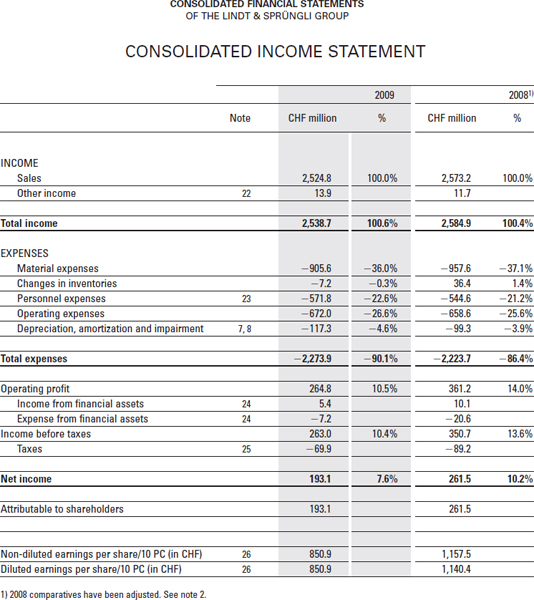
 EXHIBIT 3-24B LINDT & SPRÜNGLI GROUP 2009 ANNUAL REPORT
EXHIBIT 3-24B LINDT & SPRÜNGLI GROUP 2009 ANNUAL REPORT
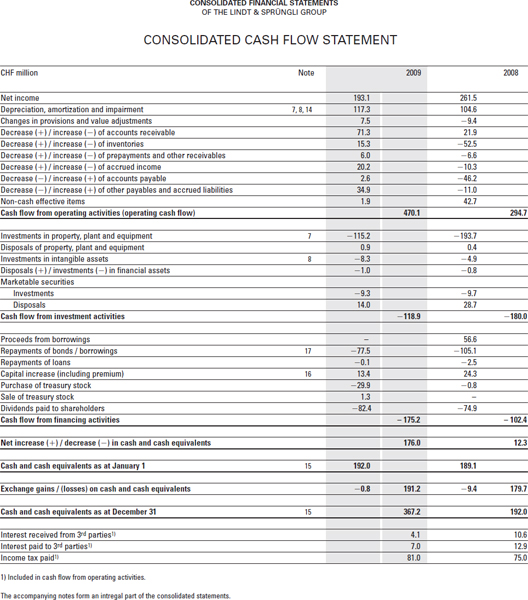
3-54 (Financial statement items with a deficit)
Groupe Bikini Village Inc. (Bikini Village) operates 63 retail stores selling beach and travel clothing throughout Eastern Canada. Use their consolidated financial statements, presented in Exhibit 3-25, to answer the following questions.
- As at January 30, 2010 what is the cumulative amount of losses the company has incurred since incorporation?
- Explain why it was not possible for the company to pay any dividends in the year ending January 30, 2010.
- If the company continues to lose money at the same rate as in the most recent year, how long would it take for the shareholders' equity to be totally eliminated? Which users of the financial statements would be concerned with the decreasing shareholders' equity? Why?
EXHIBIT 3-25A
 GROUPE BIKINI VILLAGE INC. 2009 ANNUAL REPORT
GROUPE BIKINI VILLAGE INC. 2009 ANNUAL REPORT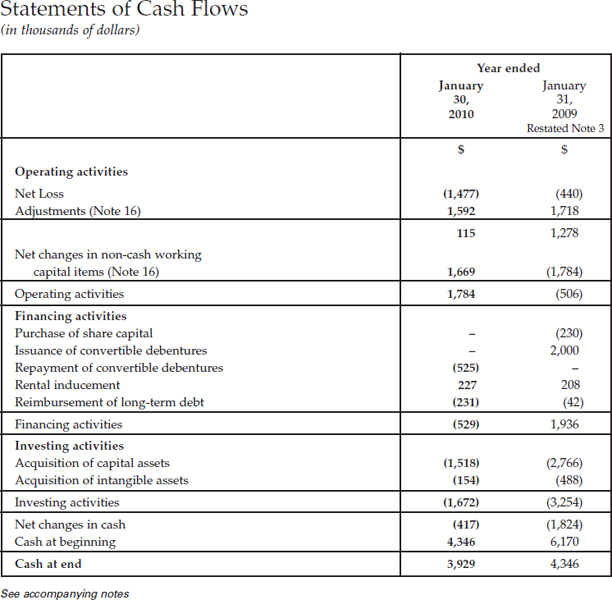
- Compare the net loss for the most recent year with the cash from operating activities. Explain how it is possible for the net income to be negative but the cash from operations to be positive. What kind of accounts or transactions would typically be included in the “Adjustments”?
 EXHIBIT 3-25B GROUPE BIKINI VILLAGE INC. 2009 ANNUAL REPORT
EXHIBIT 3-25B GROUPE BIKINI VILLAGE INC. 2009 ANNUAL REPORT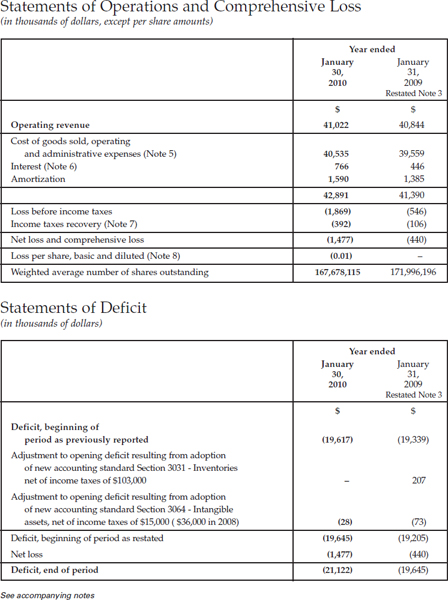
- During the year, the company purchased capital assets and intangible assets. Prepare the journal entries the company would have used to record each of those purchases, assuming they paid cash. (Hint: The amounts purchased are not equal to the increases in these accounts on the balance sheet.)
- Assuming the amortization taken during the year was only related to the capital assets and not to the intangible assets; prepare the adjusting journal entry the company would have made to record the amortization expense for the year. (Hint: Amortization can be recorded the same way as depreciation.)
EXHIBIT 3-25C GROUPE BIKINI VILLAGE INC. 2009 ANNUAL REPORT
GROUPE BIKINI VILLAGE INC. 2009 ANNUAL REPORT
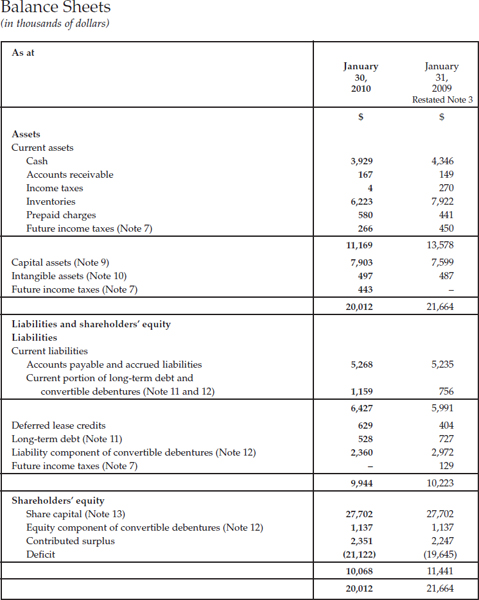
3-55 (Determining items on a Canadian financial statement)
Base your answers to the following questions on the balance sheet and statement of income of Dorel Industries Inc. in Exhibit 3-26. Based in Canada, Dorel manufactures juvenile products (strollers, car seats, etc.), bicycles, and home furniture at facilities throughout the world.
- Assuming that all the sales were on account, prepare a single journal entry to record the sales for 2009 and another entry to record the amount that was collected from customers in 2009.
- Prepare a single journal entry to record the cost of goods sold for 2009.
- As a manufacturer of products such as baby strollers, car seats, bicycles, and home furniture, what types of costs do you think Dorel incurs in producing the inventory?
- Compare the profitability of Dorel in 2009 to 2008, using the profit margin ratio and the return on assets. (Refer to Chapter 2 if you need to review the two ratios. Note that, in order to be able to calculate the return on assets for both years, you will have to use the total assets for each year, rather than average total assets.)
- During 2009 Dorel acquired four companies that produce or distribute bicycles or juvenile products in Belgium and Australia. Acquisitions normally result in an increase in assets for the acquiring company (Dorel). What was the change in Dorel's total assets from 2008 to 2009? Which asset had the largest change? Comment on your findings.
 EXHIBIT 3-26A DOREL INDUSTRIES INC. 2009 ANNUAL REPORT
EXHIBIT 3-26A DOREL INDUSTRIES INC. 2009 ANNUAL REPORT
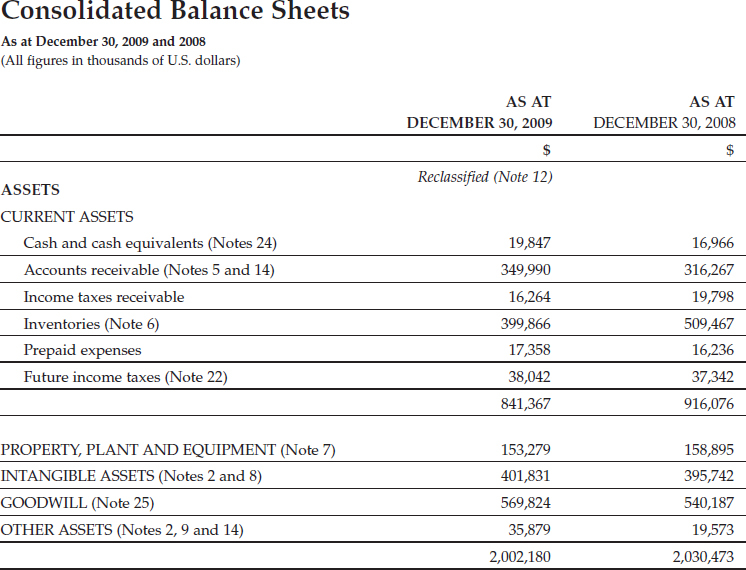
EXHIBIT 3-26B DOREL INDUSTRIES INC. 2009 ANNUAL REPORT
DOREL INDUSTRIES INC. 2009 ANNUAL REPORT

 EXHIBIT 3-26C DOREL INDUSTRIES INC. 2009 ANNUAL REPORT
EXHIBIT 3-26C DOREL INDUSTRIES INC. 2009 ANNUAL REPORT
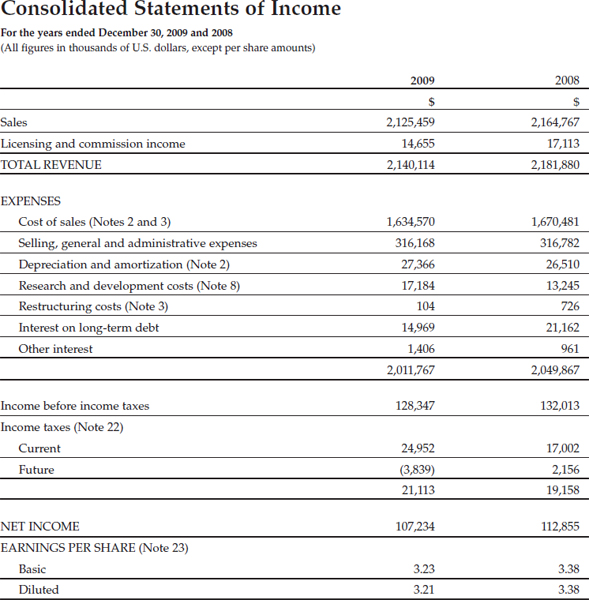
BEYOND THE BOOK
3-56 (Examine financial statement disclosures)
Find the annual report of a Canadian company that is listed on a Canadian stock exchange, and answer the following questions about it:
- Has the company prepared a classified balance sheet (statement of financial position)? If not, look for an explanation and state it briefly.
- Referring to items in the balance sheet, explain what liquidity is and how it is reflected in the preparation of the balance sheet.
- Discuss how important inventory is, compared to the other assets on the company's balance sheet. Also address how important capital assets (property, plant, and equipment) are to the company.
- Does the company rely more heavily on debt financing or equity financing?
- How many directors does the company have? What is their average age? What percentage of the board is female?
3-57 (Find additional information about a company)
For the company you selected in Problem 3-56, find at least three articles in the financial press that discuss the nature of this company's markets, and that forecast what the future may be for this sector of the economy. Write a one-page summary of your findings.
Cases
3-58 Al's Gourmet Fish
Leadfoot Al decided to retire from a successful career in stock car racing and invest all his winnings in a fish farm. He had majored in genetics in college, and he experimented with many different species of fish before coming up with a catfish that had the texture and taste of ocean trout. After incorporating Al's Gourmet Fish Company and operating for two years, he decided to explore expansion possibilities. He talked with his banker about getting a loan and presented a statement of earnings for the current year, based strictly on cash flows, as follows:

From discussions with Al, the banker learned the following:
- Of the cash collected in the current period from sales of fish, $120,000 was for shipments delivered to customers last year. All the sales made this year were collected before the end of the year.
- The fish feed can be stored indefinitely, and about 40% of this year's purchases were still on hand at year end.
- Two fish tanks were purchased last year at a total cost of $80,000. These tanks, along with the one purchased at the beginning of this year, were used all year. Each tank is expected to last five years.
- The amount for wages includes $60,000 paid to Al, as compensation for his time devoted to the business.
- There was a total of $1,000 in bills for other operating expenses for the current year that had not been recorded or paid by year end.
- The land that was sold for $130,000 had been purchased two years ago for $90,000.
Required:
Provide Al and his banker with answers to the following questions:
- What amount of revenue from the sale of merchandise should be reported in this period?
- What amount of expense for fish food should be reported in this period? How should the remainder of the food be reported?
- Should some amount for the fish tanks be included in calculating the earnings for the current period? If so, how much?
- Is it alright for Al's company to pay him wages?
- What amount for “other operating expenses” should be included in calculating the earnings for the current period?
- The land was sold for more than its original purchase price. The difference between the selling price and the purchase price of a capital asset is called a gain, and is included on the statement of earnings in the period of the sale. What amount should be included in the company's earnings as the gain on the sale of the land?
- How much did Al earn from his business this year?
- Comment on whether you think Al should stay in the fish business or go back to auto racing. In addition to financial factors, briefly describe several non-financial considerations that would be relevant to this decision.
3-59 Sentry Security Services
Samir Sarkov incorporated Sentry Security Services and began operations on January 1, 2011. After a busy year, Samir thinks his business has done well, at least in terms of the volume of work done. However, he has asked for your help in determining the financial results.
The company's accounting records, such as they are, have been kept by Mr. Sarkov's son. Although he kept good records of all the cash received and spent by the business during the year, he has no formal training in accounting. At the end of the year he prepared the following statement:
Sentry Security Services
Statement of Cash Receipts and Disbursements
For the Year Ended December 31, 2011
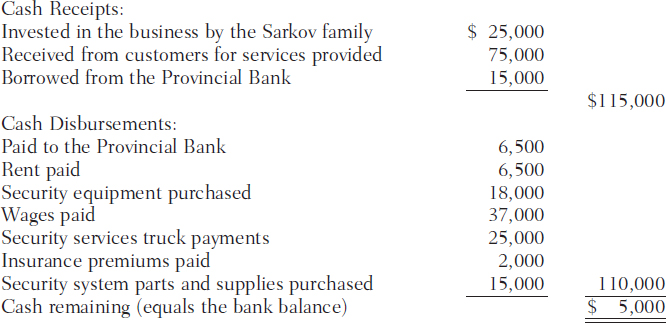
After reviewing the records, you confirm that the amounts are correct, and you also discover these additional facts:
- The business does most of its work for cash, but at the end of the year customers owe $5,000 for security services that were provided on account.
- The amount borrowed from the Provincial Bank is a three-year loan, with an interest rate of 10% per year.
- The amount paid to the bank during the year includes $1,500 of interest on the loan and $5,000 of principal.
- The rental contract for the company's space covers a two-year period and requires payments of $500 per month, paid at the beginning of each month. In addition, the last month's rent had to be paid in advance. All the required payments have been made as scheduled.
- The security equipment was purchased at the beginning of the year and has an estimated five-year lifespan, after which it will be worthless.
- In addition to the wages that were paid during 2011, $250 is owed to employees for overtime that was worked during the last few days of the year. This will be paid early in 2012.
- The security services truck payments consist of $21,000 paid to purchase the truck at the beginning of the year plus $4,000 paid for gas, oil, and repairs during the year. Mr. Sarkov expects to use the truck for four years, after which he thinks he should be able to get about $1,000 for it as a trade-in on a new truck.
- The $2,000 for insurance resulted from paying premiums on two policies at the beginning of the year. One policy cost $700 for one year of insurance coverage; the other policy cost $1,300 for two years of coverage.
- In addition to the $15,000 of parts and supplies that were purchased and paid for during the year, creditors have billed the business $500 for parts and supplies that were purchased and delivered but not paid for.
- An inventory count at the end of the year shows that $1,750 of unused parts and supplies are still on hand.
Required:
- Prepare an accrual-basis statement of earnings for the year ended December 31, 2011, and a classified statement of financial position for Sentry Security Services at the end of the year. (Hint: You may find it helpful to use T accounts for recording the transactions and adjustments, and then determining the ending balances.)
- Comment on the company's performance during its first year of operations, and its financial position at the end of the year.
3-60 Shirley's Snack Shop
Shirley Sze incorporated Shirley's Snack Shop on April 30, 2011, by investing $5,000 in cash. The following is a summary of the other events affecting the business during its first eight months of operations:
- On May 1, Shirley acquired a licence from the municipality at a cost of $150. The licence allows her to operate the snack shop for a period of one year.
- On May 2, she borrowed $10,000 from the bank and used most of it to buy equipment costing $9,600. The interest rate on the loan is 10%, and the interest is to be paid annually (i.e., each May). The entire principal amount is repayable at the end of three years. Shirley estimates that the equipment will last 10 years, after which it will be scrapped. On December 31, 2011, she estimated that the equipment could have been sold for $9,200.
- At the beginning of September, Shirley realized that she should have liability insurance and purchased a one-year policy effective immediately. The premium paid was $750.
- Her business is located in a small shop near the university campus. The rental cost is $900 per month and she has paid nine months of rent thus far.
- Shirley paid herself a salary of $1,000 a month, and a part-time assistant earned wages of $350 each month. However, she has not yet paid her assistant his wages for December.
- Shirley's purchases of food supplies, on account, cost a total of $22,500. All but $4,500 of this has been used, and she still owes the supplier $4,000. Of the food supplies that have been used, most went into snacks that were sold to customers; however, Shirley ate some of them herself, as on-the-job meals. She estimates that the snacks she consumed were purchased from the supplier at a cost of approximately $200, and would have been priced to sell to her customers for approximately $400.
- According to her bank records, Shirley received $42,300 from her customers and deposited this in the bank during the period. However, a customer still owes her $500 for snacks provided for a company party held shortly before the end of the year. The balance in her bank account on December 31 is $9,750.
- Shirley thinks that she has had fairly successful operations since opening the business. However, she has no idea how to calculate its net earnings or determine its financial position.
Required:
- Provide Shirley with a statement of earnings for the eight-month period ended December 31, 2011, and a statement of financial position as of that date.
- Comment on the snack shop's performance during its first eight months of operations, and its financial standing as at December 31, 2011.
3-61 Mbeke's Hardware Store
In the middle of January, 2012, Mark Mbeke, the owner of Mbeke's Hardware Store, decided to expand the business by buying out a local lumberyard. To finance the purchase, Mark had to obtain financing from a local bank. The bank asked Mark to provide financial statements for the year ended December 31, 2011, as support for the loan application.
Over the last year, Mark was so busy managing the store that he had no time to review the financial aspects of its operations. However, when the company's bookkeeper provided him with a set of hastily prepared financial statements for 2011, Mark was pleasantly surprised to see that the hardware store's net earnings had increased from $60,000 in 2010 to $90,000 in 2011. He commented, “With financial results like these—a 50 percent increase in earnings during the past year—we should have no trouble getting the loan.” However, further investigation revealed the following:
- On January 2, 2012, the company repaid a $140,000 loan in full, including interest. The loan was a one-year, 10% term loan. No interest expense was recorded in 2011.
- On January 3, 2012, wages of $10,000 were paid. A review of the time cards shows that these wages relate to work done in the last week of 2011.
- Goods that originally cost $11,000 and were sold in December 2011 for $15,000 were returned by the customer on January 4, 2012. Accompanying the goods was a letter that stated, “As we agreed on December 30, 2011, these goods are not what we had ordered and are therefore being returned for full credit.”
- Mbeke's Hardware received bills totalling $2,000 in the first week of January, 2012, for utilities and other operating costs incurred in 2011. They were immediately recorded as accounts payable when they were received.
Mark is concerned that some of these transactions may affect the company's financial statements for the year 2011, and therefore its ability to obtain the necessary bank financing.
Required:
- Calculate the effect of each of these items on the store's net earnings for 2011.
- By what percentage did the store's earnings increase (or decrease) over the last year?
- In light of this information, how should Mark proceed?
- What should the bank do to ensure that it is being provided with accurate financial information?
3-62 Downunder Company
You have been retained by Downunder Company to straighten out its accounting records. The company's trusted accountant for the past 25 years suddenly retired to a tropical island in the South Pacific and, in his rush to get away, he seems to have misplaced the company's accounting records. Now the bank has asked for the latest financial statements, so it can determine whether to renew the company's loan. Luckily, you managed to find the following listing of accounts and their balances, in alphabetical order, written on the back of one of the accountant's travel brochures.
| Amount invested by owners (for shares) | $20,000 |
| Amounts due to suppliers | 13,000 |
| Amounts due from customers | 20,200 |
| Cash in bank account | 1,000 |
| Cash on hand (in cash box) | 100 |
| Cost of inventory sold to customers | 41,000 |
| Cost of inventory still on shelves | 7,900 |
| Depreciation accumulated on equipment | 4,000 |
| Depreciation expense | 2,000 |
| Equipment (original cost) | 51,500 |
| Interest expense | 500 |
| Loan balance owed to Rational Bank | 15,000 |
| Miscellaneous expenses | 8,000 |
| Sales to customers | 93,600 |
| Wages expense | 27,500 |
| Wages owed to employees (not yet paid) | 1,200 |
Required:
- Based on the information available, prepare a statement of earnings for the year 2011 and a statement of financial position as at December 31, 2011. Note that there is no amount available for retained earnings, so you will have to enter whatever amount is required to make the statement of financial position balance.
- Identify several additional pieces of information that would be needed for preparing more complete and accurate financial statements. (Hint: Think in terms of the types of adjustments that would normally be made.)
*In some cases, the expenses will be larger than the revenues, resulting in a net loss for the period. If so, the retained earnings account would have to be debited (to decrease it).



